

Paragraph on Teacher
Students are often asked to write a paragraph on Teacher in their schools. And if you’re also looking for the same, we have created 100-word, 200-word, and 250-word paragraphs on the topic.
Let’s take a look…
Paragraph on Teacher in 100 Words
A teacher is a person who helps us learn new things. Think of them like a guide who shows us the path to find out more about the world. They teach us to read, write, and count. They tell us stories and show us how to draw pictures. Teachers answer our questions and help us when things seem hard. They care for us in school and cheer for us when we do a good job. They are there to make sure we are safe and happy while we learn. Good teachers make school fun and help us become smart and kind people.
Paragraph on Teacher in 200 Words
A teacher is someone who helps us learn new things. They work in schools and spend their days giving us lessons on different subjects like math, science, and English. Teachers are important because they give us the tools we need to think and solve problems. They are kind and patient, always ready to explain things as many times as we need to understand. They use books, videos, and games to make learning fun and interesting. A good teacher listens to our questions and encourages us to be curious about the world around us. They cheer us on when we do well and support us when we find something hard. Teachers also help us to be good friends and show us how to share and take turns. They care about how we feel and want us to be happy and kind to others. Every day, teachers plan activities that help us grow our brains and our hearts. They are like guides on our journey through school, making sure we are learning and having a good time. Because of teachers, we can dream about what we want to be when we grow up, and they help us work toward making those dreams come true.
Also check:
- Essay on Teacher
- Speech on Teacher
Paragraph on Teacher in 250 Words
A teacher is like a guiding star in the sky of education, showing students the way to understand the world better. Think of your favorite teacher at school. What makes them so special? It’s not just the way they explain math problems or the events of history. It’s also how they listen to you when you’re confused, cheer you on when you do well, and help you believe in yourself when you’re struggling. Teachers spend a lot of time preparing lessons so that every student can learn, no matter if the subject is easy or hard for them. They read lots of books, use the computer to find new information, and even create fun activities to make learning interesting. Good teachers also have a lot of patience. They repeat things many times to make sure everyone in the class understands. They also keep the class in order, so that everyone can learn without distractions. Besides subjects like science or language, teachers also teach us about being good people. They show us how to work with others, respect different opinions, and be honest. Sometimes, they also act like friends when we need someone to talk to. They celebrate our birthdays, encourage us after a bad day, and sometimes, they’re the first to notice when something is wrong. So, a teacher is not just someone who writes on the blackboard; they are important people who help us learn about so many things in and out of the classroom, shaping our minds and hearts for the future.
That’s it! I hope the paragraphs have helped you.
Explore other popular paragraph topics:
- Paragraph on Tea Preparation
- Paragraph on Taj Mahal
- Paragraph on Table Tennis
Apart from these, you can look at all the essays by clicking here .
Happy studying!
Leave a Reply Cancel reply
Your email address will not be published. Required fields are marked *
Save my name, email, and website in this browser for the next time I comment.
Essay on Teacher for Students and Children
500+ words essay on teacher.
Teachers are a special blessing from God to us. They are the ones who build a good nation and make the world a better place. A teacher teaches us the importance of a pen over that of a sword. They are much esteemed in society as they elevate the living standards of people. They are like the building blocks of society who educate people and make them better human beings .

Moreover, teachers have a great impact on society and their student’s life. They also great importance in a parent’s life as parents expect a lot from teachers for their kids. However, like in every profession, there are both good and bad teachers. While there aren’t that many bad teachers, still the number is significant. A good teacher possesses qualities which a bad teacher does not. After identifying the qualities of a good teacher we can work to improve the teaching scenario.
A Good Teacher
A good teacher is not that hard to find, but you must know where to look. The good teachers are well-prepared in advance for their education goals. They prepare their plan of action every day to ensure maximum productivity. Teachers have a lot of knowledge about everything, specifically in the subject they specialize in. A good teacher expands their knowledge continues to provide good answers to their students.
Similarly, a good teacher is like a friend that helps us in all our troubles. A good teacher creates their individual learning process which is unique and not mainstream. This makes the students learn the subject in a better manner. In other words, a good teacher ensures their students are learning efficiently and scoring good marks.
Most importantly, a good teacher is one who does not merely focus on our academic performance but our overall development. Only then can a student truly grow. Thus, good teachers will understand their student’s problems and try to deal with them correctly. They make the student feel like they always have someone to talk to if they can’t do it at home or with their friends.
Get the huge list of more than 500 Essay Topics and Ideas
Impact of Teachers on a Student’s Life
Growing up, our parents and teachers are the first ones to impact our lives significantly. In fact, in the younger years, students have complete faith in their teachers and they listen to their teachers more than their parents. This shows the significance and impact of a teacher .

When we become older and enter college, teachers become our friends. Some even become our role models. They inspire us to do great things in life. We learn how to be selfless by teachers. Teachers unknowingly also teach very important lessons to a student.
For instance, when a student gets hurt in school, the teacher rushes them to the infirmary for first aid. This makes a student feel secure and that they know a teacher plays the role of a parent in school.
In other words, a teacher does not merely stick to the role of a teacher. They adapt into various roles as and when the need arises. They become our friends when we are sad, they care for us like our parents when we are hurt. Thus, we see how great a teacher impacts a student’s life and shapes it.
{ “@context”: “https://schema.org”, “@type”: “FAQPage”, “mainEntity”: [{ “@type”: “Question”, “name”: “Why are teachers important?”, “acceptedAnswer”: { “@type”: “Answer”, “text”: “Teachers are the building blocks of a nation. They are responsible for making thousands of people educated. Teachers push us to do better and succeed in life.”} }, { “@type”: “Question”, “name”: “What makes a good teacher?”, “acceptedAnswer”: { “@type”: “Answer”, “text”:”A good teacher is one who is well-prepared. They always care for their students even outside the classroom. They instill good values in them and teach them subjects efficiently.”} }] }
Customize your course in 30 seconds
Which class are you in.

- Travelling Essay
- Picnic Essay
- Our Country Essay
- My Parents Essay
- Essay on Favourite Personality
- Essay on Memorable Day of My Life
- Essay on Knowledge is Power
- Essay on Gurpurab
- Essay on My Favourite Season
- Essay on Types of Sports
Leave a Reply Cancel reply
Your email address will not be published. Required fields are marked *
Download the App


80 Paragraph Writing Topics for Students and Teachers
You can have a variety of paragraph writing topics starting from personal development and social issues to globalization and philosophy.
In this brief post, I’m going to share with you a large number of paragraph writing topics that are suitable for students and teachers.
These paragraph writing topics offer students a diverse range of subjects to explore and discuss in their essays or reflections. They touch on ethics, technology, culture, mental health, science, philosophy and a lot more.
Therefore, they can serve as prompts for essays, discussions, or personal reflections for high school and college students.
So if you are a high school or university student searching for examples of paragraph writing topics then you are in the right place.
The same goes for college students and teachers who want additional material for their academic English writing course.
Here are examples of paragraph writing topics for high school and college students and tutors.
Personal Growth and Development
Discuss a significant unique challenge you’ve overcome.
Describe a person who has had a profound impact on your life and why.
Share a valuable life lesson you’ve learned recently.
Explain your long-term goals and how you plan to achieve them.
Reflect on a book or movie that changed your perspective.
11 Types of Paragraphs with Examples
20+ Free Online Degree Courses with Certificates
Education and Learning
Discuss the importance of STEM education in today’s world.
Describe your favourite teacher and the impact they have had on your education.
Explain the benefits and challenges of online learning.
Discuss the role of technology in modern education.
Share your study habits and techniques for academic success .
Social Issues and Activism
Analyze the impact of social media on mental health.
Discuss the importance of diversity and inclusion in society.
Explore the challenges faced by refugees in today’s world.
Explain the effects of bullying and ways to combat it.
Share your views on the importance of voting and civic engagement.
Beyond Borders: The Causes and Solutions to Irregular Migration
Health and Wellness
Discuss the benefits of regular exercise and a healthy diet.
Share your thoughts on the importance of mental health awareness.
Explain the effects of stress on physical and mental well-being.
Discuss the pros and cons of vegetarianism or veganism.
Analyze the role of technology in healthcare advancements.
Technology and Innovation
Explain the impact of artificial intelligence on the job market.
Discuss the ethical implications of genetic engineering.
Explore the potential benefits and risks of self-driving cars.
Share your thoughts on the role of social media in modern activism.
Describe a technological innovation that has changed your life.
Environment and Sustainability
Discuss the effects of climate change on our planet.
Explain the importance of recycling and reducing waste.
Share your views on sustainable living and eco-friendly practices.
Analyze the pros and cons of renewable energy sources.
Describe a natural wonder or ecosystem you would like to protect.
Arts and Culture
Discuss the impact of a particular art movement on contemporary art.
Describe the significance of a historical monument or landmark.
Share your thoughts on the importance of preserving cultural heritage.
Analyze the role of music in shaping society and culture.
Explain the appeal and influence of a specific genre of literature.
What are the functions of Literature?
Career and Future
Describe your dream job and the skills required to attain it.
Discuss the importance of internships and work experience for students.
Share your thoughts on the gig economy and freelance work.
Explain the benefits of entrepreneurship and the challenges it presents.
Analyze the changing landscape of the job market in the digital age.
40+ Work from School Jobs for Students
Relationships and Communication
Discuss the impact of effective communication in personal relationships.
Share your views on the role of empathy in building connections.
Explain the benefits of face-to-face communication in the digital era.
Describe a memorable family tradition and its significance.
Analyze the role of social media in maintaining long-distance friendships.
History and Society
Discuss the legacy of a significant historical figure or event.
Explain the impact of the Industrial Revolution on society.
Share your thoughts on the importance of preserving historical documents.
Analyze the role of propaganda in shaping public opinion throughout history.
Describe a historical period you would like to have lived in and why.
Top 5 Characteristics of the Swahili Civilization
11 Causes of the Rise of Nationalism in Africa
The Complete List of Asante Kings: Past to Present
Ethics and Morality
Discuss the ethical dilemmas associated with artificial intelligence and decision-making.
Share your views on the importance of honesty and integrity in personal and professional life.
Explain the concept of ethical consumerism and its impact on businesses.
Analyze the role of forgiveness in resolving conflicts and promoting healing.
Describe a moral dilemma you’ve faced and how you resolved it.
Social Media and Online Culture
Discuss the positive and negative effects of social media on relationships.
Share your thoughts on the rise of influencer culture and its implications.
Explain the role of memes in shaping internet culture and communication.
Analyze the impact of online privacy concerns on social media usage.
Describe the benefits and drawbacks of the digital detox trend.
Globalization and Cultural Exchange
Discuss the effects of globalization on local cultures and traditions.
Share your views on the importance of learning about other cultures.
Explain the benefits of studying abroad and experiencing different cultures.
Analyze the impact of international trade agreements on the global economy.
Describe a cultural festival or celebration you would like to attend.
Mental Health and Coping Strategies
Discuss the stigma surrounding mental health and strategies to combat it.
Share your thoughts on the role of art and creativity in mental health therapy.
Explain the importance of self-care routines for maintaining mental well-being.
Analyze the impact of social support networks on mental health recovery.
Describe a mindfulness or relaxation technique that has helped you.
Free Online Caregiver Course with Certificate: Alison
Science and Exploration
Discuss the significance of space exploration and its potential benefits.
Share your views on the ethical considerations of genetic cloning.
Explain the impact of recent scientific discoveries on medicine and healthcare.
Analyze the challenges and possibilities of colonizing other planets.
Describe a scientific theory or concept that fascinates you.
Philosophy and Existential Questions
Discuss the concept of free will and its implications for human existence.
Share your thoughts on the meaning of life and the pursuit of happiness.
Explain the philosophical arguments for and against the existence of a higher power.
Analyze the ethical implications of artificial intelligence achieving consciousness.
Describe a philosophical quote or idea that has influenced your thinking.
Final Thoughts
The above paragraph writing topics should inspire you to craft your best paragraphs for any essay you may have to write.
You might also like another post on paragraph writing best practices for high school and college students.
SHARE THIS POST

Recommended

Solutions to Environmental Pollution Essay Example

Causes of Environmental Pollution Essay Example

Effects of Environmental Pollution Essay Example

30 Examples of Sentences that Omit ‘that’

Reading Comprehension Practice Online

Figures of Speech vs Literary Devices: What’s The Difference?

WAEC Lexis and Structure Part 4: Past Questions and Answers

4 Types of Sentence Structure with Examples (Plus Definition)

The Easiest Way to Identify a Phrase in a Sentence

QS World University Rankings: The Best Global Universities

From Harvard to HEC Paris: 23 Top Business Universities in the World

WAEC Lexis and Structure Part 3: Past Questions and Answers
Leave a comment cancel reply.
Your email address will not be published. Required fields are marked *
Save my name, email, and website in this browser for the next time I comment.
Sign me up for the newsletter!
This site uses Akismet to reduce spam. Learn how your comment data is processed .
Get Dependable High School General Arts Textbooks
Ideas for Teaching How to Write a Paragraph
- Differentiation , Planning , Strategies , Writing
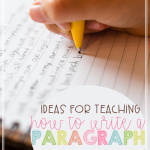
Many students struggle to put together one paragraph, let alone the multi-paragraph essays that common core requires them to do. Since they often lack the ability to put together a paragraph, writing often becomes a chore and they lack the motivation to do any form of writing. So just how do we get out of this writing rut so that students can become engaged and learn to write a paragraph (and eventually the required multi-paragraphs)?
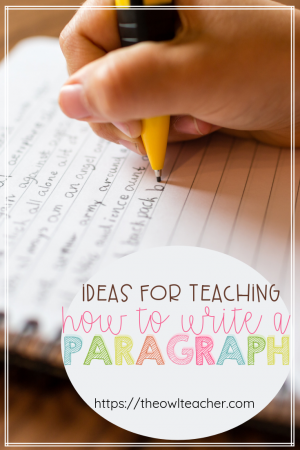
Ideas to Teach Writing a Paragraph
Start with the basics. When teaching students about paragraphs, we talk about the hard and fast rules, such as indenting, having approximately 3-5 sentences, and the structure of it. While I know paragraphs are not set in stone at 3-5 sentences, nor do they always have a main idea as the topic sentence, I like to give my students structure for the foundations and then as they progress expand a bit more with the “hard and fast” rules.
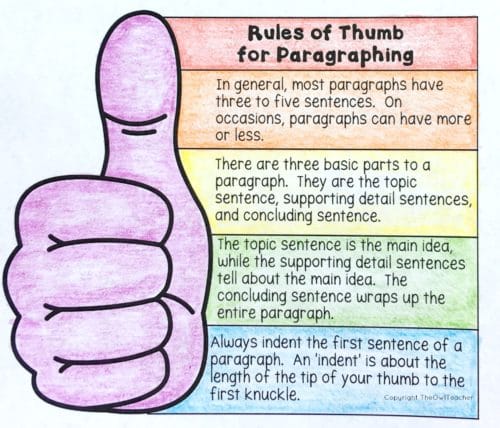
The Parts of a Paragraph. After we discuss the general “rules” of paragraphing, I then provide my students with sample paragraphs to analyze for the basic structure. We go through paragraphs and highlight the topic sentence, the supporting details, and the concluding sentence. I want students to start noticing that paragraphs always have a main idea and supporting details. Not only is this important for writing, but it helps them when it comes to reading. When you pull out highlighters, students are instantly engaged !
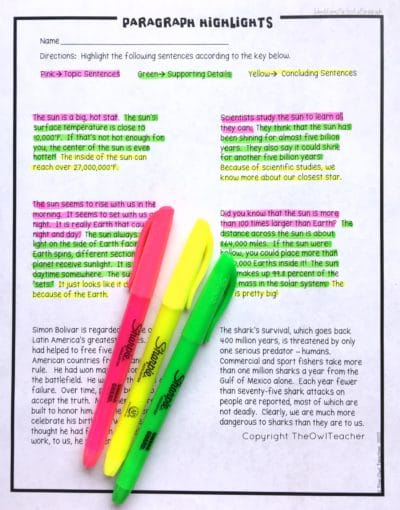
Sorting Strips Once students have gotten down to the basic structure of paragraphs, then I provide students with a paragraph that has been cut up into sentence strips. Each sentence of the paragraph is on its own strip and students have to determine which strip is likely the topic sentence, the concluding sentence, and supporting details. They also place the strips in order. This helps students take note of the characteristics of each type of sentence. For instance, a student is more likely to notice that a main idea sentence will sound very different from a supporting detail or a concluding sentence. This also helps them practice the flow of a paragraph.
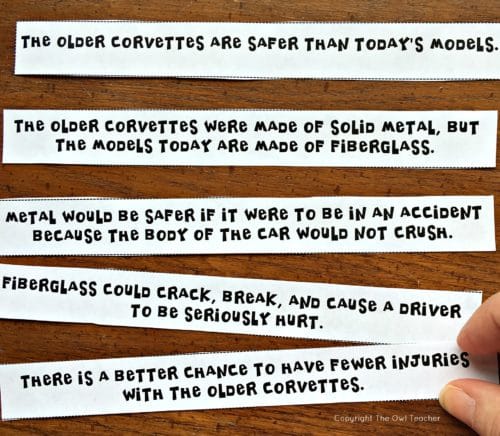
Turning Lists into Paragraphs Once students really have the foundations of a basic paragraph down, I then start focusing on each individual piece. For instance, I might provide students with many supporting details and have them try to come up with a topic sentence. I may also provide students with a list of topic sentences and they have to brainstorm a list of supporting details. Another idea is to provide students with an object and have them make a list of ways it can be used. Then I work with my students to turn these lists into a paragraph.
Check out these related products
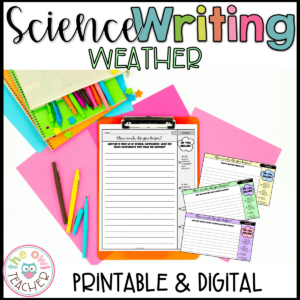
Writing Frames Another option I remember learning while attending an Anita Archer conference (and is very successful for emergent writers) is using writing frames. In this case, the basic premise of a paragraph is set up for a student and they fill in the examples. See below.
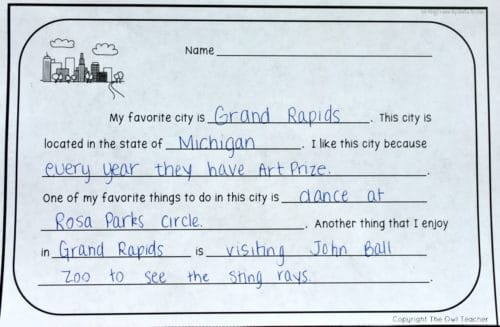
Guided Writing After we have experimented a bit with creating topic sentences and supporting details, then I guide my students into writing their own paragraphs off the top of their heads. I walk them through each part step-by-step. We usually create a booklet together to make it motivating.
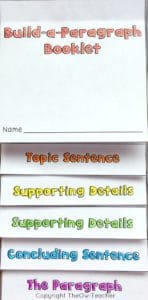
Final Writing with Graphic Organizers Once we have worked together through these steps of scaffolding , I then provide students with a graphic organizer and let them loose to create their own paragraph independently . I try to make it engaging by having them create their own Paragraph Sandwich. My students really enjoy this activity and they turn out really great!
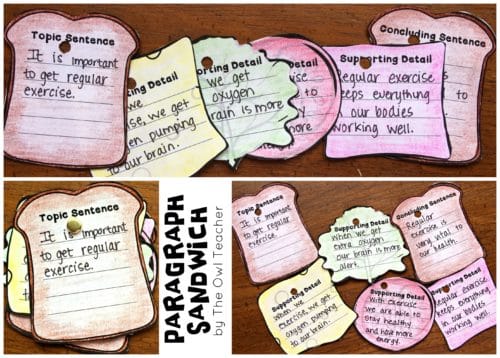
Hopefully, you can find some of these ideas useful in teaching your students about writing paragraphs. After students have the basic structure of writing paragraphs down, then you can begin moving into stretching those paragraphs with elaboration and much more!
Looking for a quick and easy way to implement these activities? You can find them (plus more!) in my store for an inexpensive price!

FIND IT NOW!
Check me out on tpt.

CHECK THESE OUT

Three Types of Rocks and Minerals with Rock Cycle Circle Book

Partitioning Shapes Equal Share Fractions Halves, Thirds, Fourths Math Puzzles
Want to save time?
COPYRIGHT © 2016-2024. The Owl Teacher | Privacy page | Disclosure Page | Shipping | Returns/Refunds
BOGO on EVERYTHING!

151+ Paragraph Writing Topics [Trending + Evergreen] For Students
Students and teachers who are seeking paragraph writing topics, this is the place where you will get a massive list of 100+ Paragraph Writing Topics from different categories. You will also get some of the examples that have been already written to help you get an idea of how to start writing.
Paragraph Writing is an essential activity for students that not only helps brush up their writing skills but also enables them to boost their knowledge in various areas. You can get a number of benefits out of paragraph writing. Some of them are:
Benefits of Paragraph Writing:
- Teaches you how to plan
- Helps you gain more knowledge about different things
- Let you know how to influence others
- Helps you sharp up your analytical brain
- Helps you understand others aspectations from you
List of Paragraph Writing Topics For Students
The provided list of Paragraph Writing Topics is suitable for students studying in classes 6, 7, 8, 9, 10, 11 And 12. The topics are categorised into many categories to help students skim through easily.
Paragraph Writing Topics About yourself
- Paragraph on myself
- Paragraph on my school
- Paragraph on my teacher
- Paragraph on my home
- Paragraph on my village
- Paragraph on my country
- Paragraph on my family
- Paragraph on my mother
- Paragraph on my brother
- Paragraph on my best friend
- Paragraph on my sister
- Paragraph on my grandparents
- Paragraph on my hobby
- Paragraph on my birthday party
- Paragraph on my favourite game
- Paragraph on my favourite book
Paragraph Writing Topics On Student Life
- Paragraph on my favourite subject
- Paragraph on my favourite teacher
- Paragraph on my favourite sports
- Paragraph on my visit to a picnic
- Paragraph on my visit to a zoo
- Paragraph on my visit to Taj Mahal
- Paragraph on how I spent my summer vacation
- Paragraph On Picnic With Family
- Paragraph On My Aim In Life
- Paragraph On First Day At School
- Paragraph On An Ideal Student
- Paragraph On Friendship
- Paragraph On Duties Of A Student
Paragraph Writing Topics About Lifestyle
- Paragraph On Discipline
- Paragraph On My Hobby
- Paragraph On Gardening
- Paragraph On Book Fair
- Paragraph On Travelling
- Paragraph On Reading
- Paragraph On Health Is Wealth
- Paragraph On Hygiene
- Paragraph On Honesty
- Paragraph On Fast Food
- Paragraph On Physical Exercise
- Paragraph On Leisure
- Paragraph On Courage
- Paragraph On Importance Of Money
- Short Paragraph On Importance Of Education
- Paragraph On Morning Walk
- Paragraph On Bicycle
- Paragraph On The Importance Of Good Health
- Paragraph On Study
- Paragraph On Self Help Is The Best Help
- Paragraph On Unity
- Paragraph On Communication
- Paragraph On Fashion Among Students
- Paragraph On Aim In Life
- Paragraph On Cleanliness
- Paragraph On Value Of Time
- Paragraph On Time Management
- Paragraph On Punctuality
- Paragraph On Good Manners
- Paragraph On Teamwork
- Paragraph On Peace
- Paragraph On Picnic
- Paragraph On Books
- Paragraph On Summer Vacation (summer Holidays)
- Paragraph On Sharing And Caring
- Paragraph On Healthy Habits
- Paragraph On Truthfulness
- Short Paragraph On Dussehra
- Paragraph On Our National Flag
- Paragraph On Indian Festivals
- Paragraph On Our School Library
- Paragraph On Historical Place
- Paragraph On Hill Station
Paragraph Writing Topics About Environment
- Paragraph On Save Water
- Paragraph On Pollution
- Paragraph On Water Pollution
- Paragraph On Air Pollution
- Paragraph On Noise Pollution
- Paragraph On Soil Pollution
- Paragraph On Importance Of Trees + Grow More Trees
- Paragraph On Wildlife Conservation
- Paragraph On Sustainable Development
- Paragraph On Deforestation
- Paragraph On Aforestation
- Paragraph On Drought
- Paragraph On Earthquake
- Paragraph On Natural Disaster
- Paragraph On Rainy Season
- Paragraph On Rainy Day
- Paragraph On Summer Season
- Paragraph On Winter Season
- Paragraph On Autumn Season
- Paragraph On Spring Season
- Paragraph On Biodiversity
- Paragraph On Tiger
- Paragraph On Peacock
Paragraph Writing Topics For Country and Personalities
- Paragraph On Patriotism
- Paragraph On Farmers
- Paragraph On Dignity Of Labour
- Paragraph On Freedom Fighters
- Paragraph On Mahatma Gandhi
- Paragraph On Swami Vivekanand
- Paragraph On Subhash Chandra Bose
- Paragraph On Rabindranath Tagore
- Paragraph On Apj Abdul Kalam
- Paragraph On Cv Raman
- Paragraph On Jawaharlal Nehru
- Paragraph On Lal Bahadur Shastri
- Paragraph On Bhagat Singh
- Paragraph On Rani Laxmi Bai
- Paragraph On Chhatrapati Shivaji
- Paragraph On Mother Terresa
- Paragraph On Aryabhatta
- Paragraph On Br Ambedkar
- Paragraph On Raja Ram Mohan Roy
- Paragraph On Sardar Vallabhbhai Patel
Paragraph Writing Topics On Social Issues
- Paragraph On Women Education
- Paragraph On Women Empowerment
- Paragraph On Overpopulation
- Paragraph On Brain Drain
- Paragraph On Corruption
- Paragraph On Dowry System
Paragraph Writing Topics About Science & Technology
- Paragraph On Science
- Paragraph On Technology
- Paragraph On Computer
- Paragraph On Internet
- Paragraph On Cell Phone
- Paragraph On Transport
- A Paragraph On Traffic Jam+ Traffic Rules
- Paragraph On Science In Everyday Life
- Paragraph On Social Networking
- Paragraph On A Day Without Electricity
- Paragraph On Information Technology
- Paragraph On Artificial Intelligence
- Paragraph On Virtual Reality
- Paragraph On Internet of Things
- Paragraph On NFT
- Paragraph On Blockchain Technology
- Paragraph On Automation
- Paragraph On Robotics
- Paragraph on Engineering
- Paragraph On Wonders Of Science
- Paragraph On Save Electricity
Paragraph Writing Topics Related To Proverbs
- Paragraph On Honesty Is The Best Policy
- Paragraph On Prevention Is Better Than Cure
- Paragraph On Hard Work Is The Key To Success
- Paragraph On Work Is Worship
- Paragraph On Time And Tide Wait For None
- Paragraph On All That Glitters Is Not Gold
- Paragraph On A Stitch In Time Saves Nine
- Paragraph On Actions Speak Louder Than Words
- Paragraph On Laughter Is The Best Medicine
- Paragraph On Knowledge Is Power
Some Other Topics
- Paragraph On If I Were A Bird
- Paragraph On Life In A Big City
- Paragraph On Village Fair
- Paragraph On Village Life
Read Paragraphs:

- Paragraph On Summer Season in 100 Words
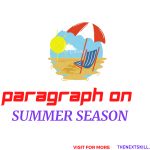
- Paragraph on a Visit to a Zoo in 100 Words

- Short Paragraph on a Journey by Bus

- Paragraph on Clean India Mission
- Paragraph on Mobile Phone For Students

Related Posts

Paragraph on My Life [100-200 Words]

Paragraph on Summer Season In 200 Words

3 [Short & Long] Paragraphs On A Journey by Bus
The Joy of Teaching
Sharing creative ideas and lessons to help children learn.

Writing Fabulous Sentences and Paragraphs: How to Teach Beginning Writing
August 19, 2019 by Evan-Moor | 0 comments

Developing students’ writing takes practice and hard work throughout the year, and it can be difficult to transition young students’ basic writing into detailed and descriptive sentences. Teaching early writing components such as expanding sentences, beginning paragraphs, identifying topic sentences, including details, and writing conclusions are all small skills that your students can master to enhance their writing.
Take a look at the following resources and lessons to help your students improve their writing.
Write a Super Sentence for Grades 1–3
Developing students’ writing from simple sentences to expanded sentences is an ongoing battle throughout the school year. Give your students practice expanding their sentences with Write a Super Sentence .

The super sentence template allows students to see how simple sentences can become more interesting by including more information.
Find individual lesson downloads from this resource for writing super sentences on Teachers Pay Teachers:

- Super Sentence Starter: Many Bees Buzzed.
- Super Sentence Starter: That witch flew.
- Super Sentence Starter: The leprechaun hid.
Paragraph Writing for Grades 2–4
Students begin paragraph writing around grade two, and they are often confused by several descriptive sentences strung together, as well as by a paragraph’s components and structure. Before asking students to write a paragraph, teach them how to identify the parts of a paragraph. Spend time reviewing:
- Topic sentences/main ideas
- Detail sentences
- How to write conclusions

Paragraph Writing for grades 2–4 provides sample paragraphs that give students practice locating main ideas and topic sentences within a paragraph. Teach students to identify a topic sentence by asking questions such as:
- What is the most important or main idea of this paragraph?
- Which sentence tells you this idea?

Many times students will write a paragraph with many details but no topic sentence. This activity is a great way to help them formulate a topic sentence.
1. Write a list of details about a topic.
- build a nest
- lay eggs in the nest
- sit on the eggs
- gather food for the hungry babies
2. Read the details and discuss what they have in common.
3. Ask students to write sentences on the board.
Possible examples are:
A mother bird does many things. Birds are good mothers.
4. Explain that the sentences could be used as the topic sentence of a paragraph containing the information about a list of details. 5. Have students select one of the topic sentences created earlier and write a paragraph containing information the list of details provided.Provide students more practice with for grades 2–4 . The guided lessons will have students writing narrative, descriptive, how-to, and compare-and-contrast paragraphs in no time.
Provide students more practice with Paragraph Writing for grades 2–4. The guided lessons will have students writing narrative, descriptive, how-to, and compare-and-contrast paragraphs in no time.

Find individual lesson downloads from Paragraph Writing on Teachers Pay Teachers:
- Paragraph Writing: What’s My Topic Sentence?
- Paragraph Writing: Supporting Details
Writing Fabulous Sentences and Paragraphs for Grades 4–6
Figurative language is an extremely useful part of creative writing, but similes and metaphors are often confusing for young students. Review the differences between similes and metaphors and show examples of them to students.
- A simile compares two things using “like” or “as.” For example: The waves were as big as dinosaurs.
- Metaphors are more difficult to teach than similes. They often use fewer words and do not have the signals of “like” or “as.”
Students can practice writing their own similes with this simple exercise. Give your students a list of three items
1. Have students list three things they could compare to each of these items. 2. Using their lists of comparisons, have students write three similes for each item.
Extend this activity with a writing component! Ask students to write a full paragraph using one of their similes or metaphors! Their paragraph should include a topic sentence, supporting details, a simile, and a concluding sentence.

Find individual lesson downloads from for writing paragraphs from this resource on Teachers Pay Teachers:
- Using Figurative Language: Similes and Metaphors
- Using Figurative Language: Personification and Alliteration
Writing Instructions for an Alien for all Ages
This activity is fun and challenging for all ages, and focuses on descriptive language and adding details to writing.
- Have your class pretend they’re writing instructions for an alien who has never been to Earth.
- Making a peanut butter and jelly sandwich
- Watering plants
- Taking the dog on a walk
- Example: Pick up the cylinder container with a blue wrapper and a thick, light brown substance inside. This is called peanut butter. Pick up the silver, pointy tool next to the container. This is a knife. etc.
- Have fun with this! This activity can be very fun and surprisingly difficult. It can be adapted for any age student.
Though it may be difficult to engage kids in narrative writing, there are so many ways to make it more fun and interesting for students and teachers. Activities like the ones listed above will make creative writing less challenging and more enjoyable. Encourage your students to write just as they would tell a story to their friends, with lots of details, jokes, and descriptors!

Leave a Reply Cancel reply
Subscribe Today!
Sign-up for education inspiration for PreK–8 teachers and parents.
Email address:
Grade Level Pre-K Kindergarten 1st Grade 2nd Grade 3rd Grade 4th Grade 5th Grade 6th Grade 7th Grade +
Profession Teacher Homeschooler Parent School Admin Other
By submitting this form, you are consenting to receive emails from Evan-Moor. You can unsubscribe at any time by using the Unsubscribe link found at the bottom of every email.

Perfect Paragraph Writing: The Ultimate Guide
Perfect paragraph writing is easy
A glance around any shopping mall crowded with teenagers on school break would suggest that our young people spend a reasonable amount of time writing. Sure, most of this writing is done with their thumb on a screen, but it’s still writing.
Yes, but tapping out a 280-character Tweet isn’t the ideal route to constructing well-organized writing pieces. To prepare our students to write coherently, they need to understand how to organize their ideas on paper. The ability to write strong paragraphs is an essential part of this.
Unfortunately, recent studies show that surprisingly few college graduates can achieve this, despite writing and communications skills being the most requested job requirements across all industries – including engineering and IT. Clearly, there is a pressing need for a strong focus on writing skills in the classroom.

For the most part, we live in a post-illiterate world. We can all read and write. This is undoubtedly a great thing, but it can lead to complacency for some of our students. At times there is an unwillingness to learn the craft of writing. A reluctance to learn how to organize writing in favor of just plunging in. The cost of this devil-may-care approach is, most often, clarity and coherence.
Fortunately, teaching what appears to be an apparently amorphous skill, such as writing, can be broken down into transparent step-by-step processes, and this includes how to write well-structured, coherent paragraphs.
A COMPLETE UNIT ON TEACHING PARAGRAPH WRITING

This complete PARAGRAPH WRITING UNIT takes students from zero to hero over FIVE STRATEGIC LESSONS to improve PARAGRAPH WRITING SKILLS through PROVEN TEACHING STRATEGIES.
BE SURE TO READ OUR COMPLETE GUIDE TO SENTENCE STRUCTURE

Before you can master paragraph writing, you will need a good understanding of constructing meaningful sentences.
We have a complete guide to sentence structure for teachers and students. Click here to view.
WHAT IS A PARAGRAPH? A DEFINITION

To teach our students how to effectively write paragraphs we need to clearly define what a paragraph is. Assuming your students understand how to construct a solid sentence, paragraphs are the next step to creating a lucid piece of writing. They are the main building blocks in the construction of a comprehensible text.
Paragraphs are a group of single sentences united by a single topic or idea that help keep writing organized. They help the writer organize their thoughts during the writing process and further help the reader follow the thread of those thoughts in the reading. How paragraphs are used will depend, to some extent, on the genre of writing the students are engaged in, but any piece of writing longer than a few sentences will generally benefit from being organized into paragraphs.
A simple way to help students to recognize paragraphs is to have them count the number of paragraphs on a page, either in a book or projected onto the whiteboard. Have them note too, that there are two ways to delineate a paragraph: indentation or skipping a line. Both methods are fine, just ensure the student chooses one method and sticks to it. If you indent there is no need to skip a line – and vice versa.
Writing starts with planning. It’s a bit like gazing at a beautiful cathedral or temple we visit on vacation. Once it was obscured by scaffolding and busy workers that were eventually peeled away to reveal the beauty beneath. The planning stage of writing serves the same purpose as architectural blueprints, that is: to foresee the problems of construction and solve them before building begins. It is often helpful to consider paragraphs as distinct units in the planning process. Now, let’s take a look at the structure of paragraphs and how they work.
HOW TO STRUCTURE A PARAGRAPH
The three-part structure of an essay – introduction, body, and conclusion is echoed in the underlying structure of most paragraphs. There are two concepts essential to understanding in the writing of the perfect paragraph:
i. Thesis Statement: The thesis statement represents the main idea of the text as a whole and usually occurs in the opening paragraph.
ii. Topic Sentence: The first sentence of each paragraph thereafter usually introduces a single central idea in support of the previously mentioned thesis statement.
The topic sentence also serves the purpose of unifying the other sentences in the paragraph, while further setting up the order of those sentences. While the majority of paragraphs will contain a topic sentence and that topic sentence will come first, there are, as always, some exceptions. A narration of the sequence of events may not require the use of a topic sentence or changing paragraphs because of a change of speaker in dialogue, for example.
Subsequent sentences following the topic sentence should all relate back to the topic sentence and either discuss the point raised or support that point through the provision of evidence and examples. A good acronym that conveys this is P.E.E.L.
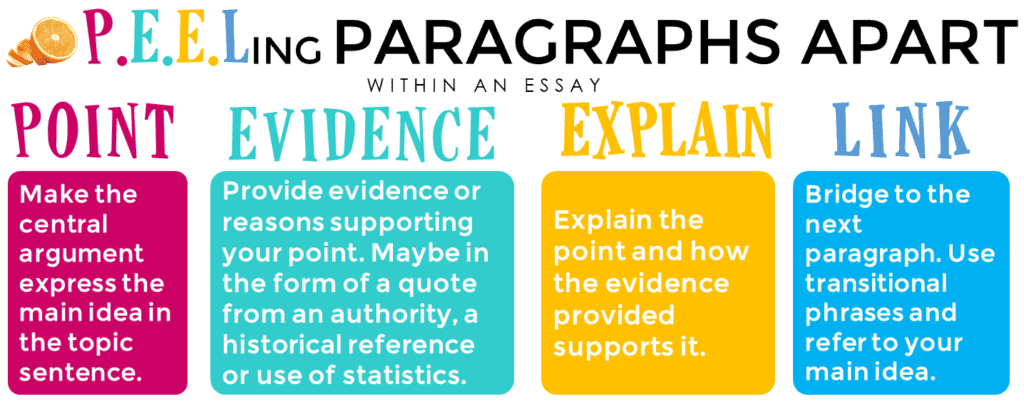
Point: Make the central argument or express the main idea in the topic sentence.
Evidence: Back up the point made by providing evidence or reasons. Evidence may take the form of quotations from a text or authority, reference to historical events, use of statistics etc.
Explanation: Explain the point and how the evidence provided supports it.
Link: Provide a bridge into the next paragraph at the end of the current paragraph by using a transition that links to the next paragraph and the main idea or thesis statement.
WHEN TO BEGIN A NEW PARAGRAPH
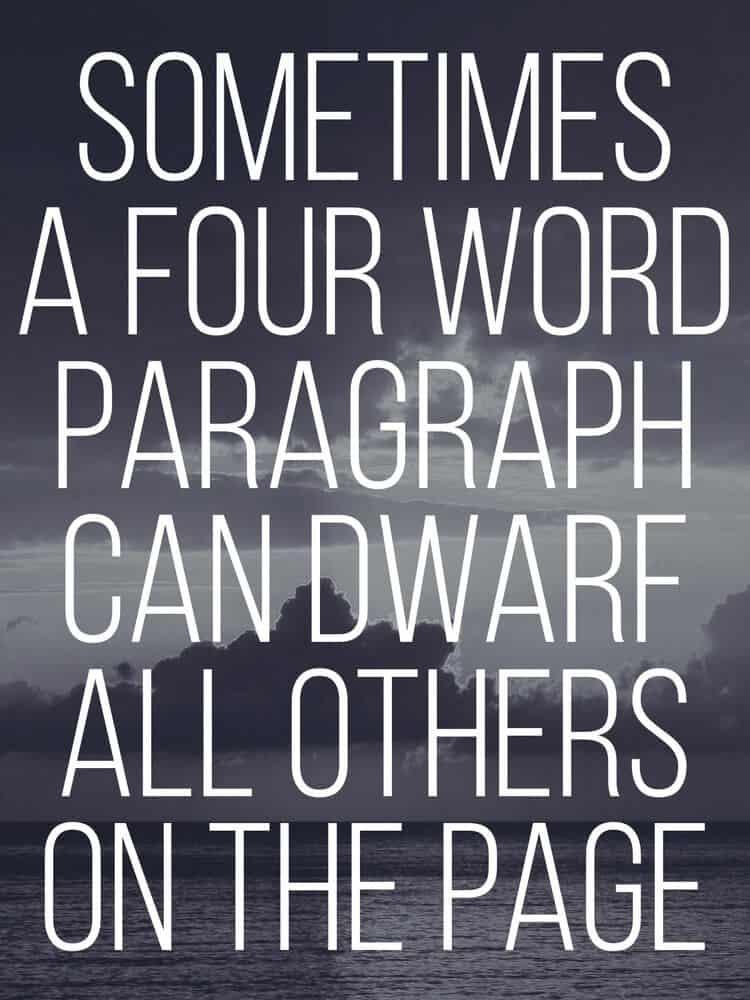
One of the more common difficulties for students is to recognize when it is time to begin a new paragraph. This often occurs because the student fails to distinguish between the thesis statement and the topic sentence. While the thesis (or more broadly, the theme) will remain consistent throughout the piece of writing, each paragraph should focus on a different point in support of that thesis.
Another useful way to determine when to start a new paragraph is to note that a new paragraph is necessary when there is a change of focus on a:
Person: This could be a character in a story or an important figure in history, for example. This could also refer to a change in speaker when writing dialogue. When there is a significant shift in focus from one person to another in a piece of writing, it’s time to indent or skip a line!
Place: As with a changing focus on a person, a shift from one location to another is most often best noted with a corresponding change in paragraphing. Instruct students that a move to a new paragraph in their writing is symbolic of the physical change of place – this will help them remember to start a new paragraph.
Time: Important shifts in time most often require a new paragraph too. These changes in time may be a mere matter of minutes or a significant movement through different historical periods. If the change in time opens up new material to the reader, students must mark this in their paragraphing.
Topic: Though usually united by the thesis statement or similar, a piece of writing will often explore clearly differentiated topics in its course. Usually, these topics will become apparent during the planning process. Each clearly identified topic will require at least one dedicated paragraph.
HOW LONG IS A PARAGRAPH? / HOW MANY SENTENCES IN A PARAGRAPH?
The question of how many sentences are in a paragraph, or how long is a paragraph is a common one. Unfortunately, there is no definitive answer to this question as quality paragraphs are measured in the ideas and concepts addressed rather than sentences and word counts.
Analytics of millions of paragraphs tell us that most paragraphs are approximately 100 – 200 words in length and are made up of 3 – 5 sentences but it must be stressed that this is purely a statistical coincidence and nothing more.
Excellent paragraphs can range from 12 words to 12 sentences when written correctly as you will discover from this guide.
HOW TO WRITE AN INTRODUCTION PARAGRAPH

Your introductory paragraph should contain the thesis statement. The Thesis statement usually appears at the middle or end of the introductory paragraph of a paper, providing a concise summary of the main point or claim of the piece of writing.
Your thesis statement should not exceed one sentence and is a guiding light for your essay or piece of writing.
The last sentence of an introduction paragraph should also contain a “hook” driving the reader to the next paragraph and onwards throughout your piece of writing as a whole.
Daily Quick Writes For All Text Types

Our FUN DAILY QUICK WRITE TASKS will teach your students the fundamentals of CREATIVE WRITING across all text types. Packed with 52 ENGAGING ACTIVITIES
HOW TO WRITE A CONCLUSION PARAGRAPH
The purpose of your conclusion is to wrap up your piece of writing as a whole. In your conclusion, you should summarize what you initially stated in your thesis statement without just repeating it word for word.
Your conclusion is not the place to bring up new ideas or evidence which should have been addressed before this point. In some instances, though you may raise questions or direct your reader to reconsider a specific aspect of your writing in an effort to challenge their thinking beyond this point. This is common practice in persuasive writing and some narrative styles such as mystery writing.
The final sentence of your conclusion will leave a lasting impression on your audience so never rush or disregard it. It is one of the most important sentences you will write.
Be sure to read our complete guide to writing a conclusion paragraph here.
TOP 5 TIPS FOR PARAGRAPH WRITING
● Consistency is Key – Encourage students to be consistent in their verb tenses and point of view. For example, shifts from the past tense to present tense without good reason can be as disorientating as time travel itself.
● Use Transition Words and Phrases – These words and phrases are a great way to link concepts and ideas within a paragraph, as well as helping to form a bridge to the next paragraph. Some useful transitional words and phrases include: although, in spite of, therefore, for this reason, as a result.
● Employ Parallel Structures: Using parallel structures brings flow to a piece of writing, making it easier to read and understand for the reader. Parallel structures involve using two or more phrases or sentences that use the same parts of speech and grammatical structures. Not only does this make the writing easier to read, but it also helps the reader make connections between ideas.
● Breathe Life into the Writing: We often forget that the origins of the written word lie in speech. We lose a lot of the color and expression of the spoken word when we lay it out cold on the page. Fortunately, students can breathe life back into their words with a few simple techniques. Encourage your students to imbue their writing with color and vitality by weaving anecdotes, verbal illustrations, rich details, and facts and figures throughout their writing. Judiciously chosen, these techniques will have their writing rosy-cheeked in no time!
● Edit and Proofreading: Unlike speaking, with writing you get more than one bite at the verbal cherry. Writing is a craft and like any craft, some refining is required. Ensure your students take the time to polish their final draft.
WRITING CHECKLISTS FOR ALL TEXT TYPES

TO PERFECT THE PARAGRAPH – PRACTICE!
Clarity comes from organization and without the ability to organize their own thoughts prior to writing, students will not be able to coherently express their thoughts and ideas to their readers. It is essential that students develop a clear and consistent approach to paragraph writing that is repeatable. This can only be attained through lots of practice – which means lots of writing.
However, the principles underlying strong paragraph writing can also be reinforced through reading. Take the opportunity to reinforce good writing practices when engaged in classroom reading activities too. Repeatedly identify, and have students identify, the concepts and techniques discussed above until they become second nature. The more familiar students become with these concepts, the more they will naturally permeate the student’s writing. Getting a firm grasp on the mechanics of paragraph writing will make their communication much more effective. A skill that is hard-won, but easily carried.
PARAGRAPH WRITING TUTORIAL VIDEO
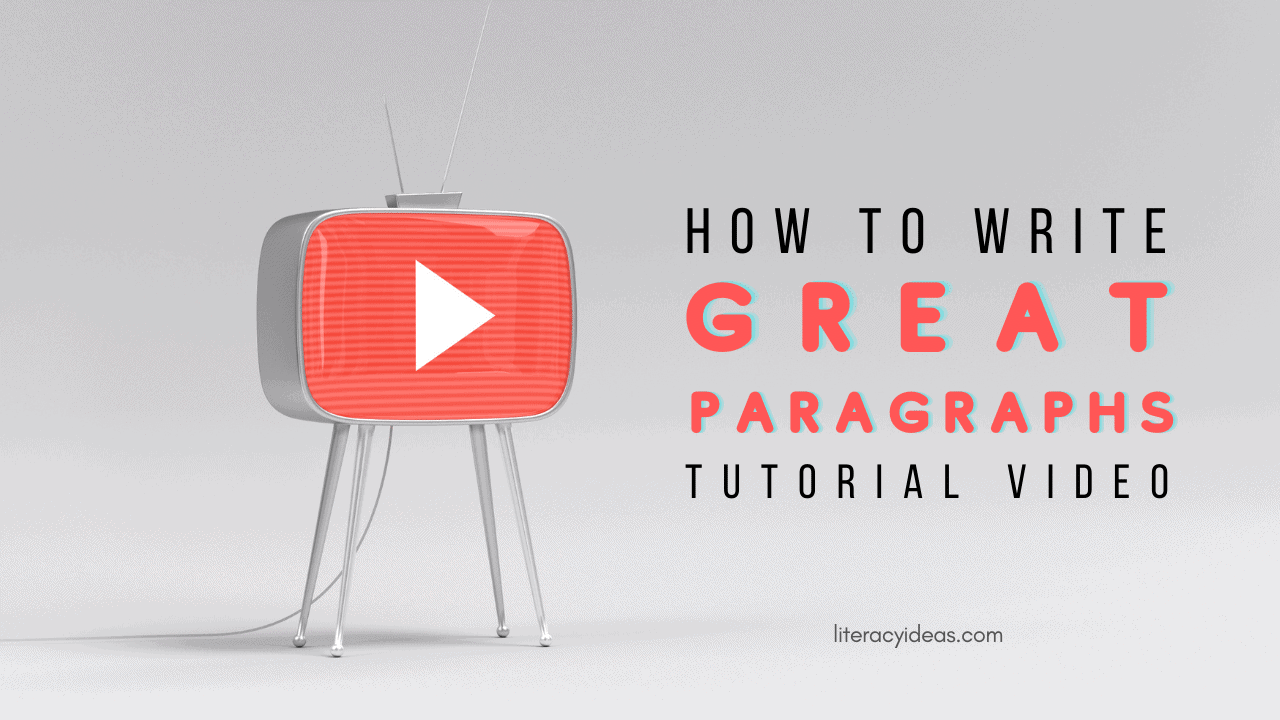
New Product! Create Academic and Professional Success with “Academic Vocabulary”!

Ultimate Guide to Teaching Paragraphs and Understanding Paragraphs
What is a paragraph? You must be able to answer that question for yourself to teach paragraph and multi-paragraph writing effectively. Well, congratulations! You are about to enter a rare and elite club of teachers who truly understand paragraphs. We are going to explore sixteen different paragraph topics and peel back the curtain topic by topic to reveal the true nature of paragraphs.
By the way, this page is primarily for teachers. If you want to teach paragraph and multi-paragraph writing in a way that makes sense to your students, be sure to check out Pattern Based Writing: Quick & Easy Essay on the homepage!
1. What’s the Truth about Paragraphs?
I’ve always found that students benefit from a certain amount of clear, concrete, rigid, and simplistic paragraph instruction. But does that kind of information that we teach our students about paragraphs match the paragraphs our students read in newspapers, magazines, textbooks, letters, notes, emails, bulletins, picture books, and chapter books? No.
In 1866, Alexander Bain laid down the six laws of the paragraph, and ever since, textbooks and teachers have repeated the same basic information about paragraphs. Unfortunately, few people know that many researchers have said that those rules don’t exist in the real world. As an example, in the highly cited The Frequency and Placement of Topic Sentences in Expository Prose (1974), Braddock found that only 13% of professionally written expository paragraphs began with a topic sentence, and only 55% of expository paragraphs even had one.
Even today, academic researchers and theorists debate what a paragraph is. Plenty of people have presented models, but none have replaced Bain’s model in the minds of teachers.
2. Paragraph is a Verb: The Research Proves It
Why don’t all paragraphs look the same? The answer is simple: different writers paragraph differently. In fact, researchers (Arthur A. Stern in particular) have done experiments where they remove the paragraph formatting from a text and then ask English teachers to re-paragraph the text. Few teachers end up paragraphing the text the same way as the author. The result is that a surprisingly large number of so-called correct paragraph formats emerge.
Furthermore, when the researchers ask the English teachers to re-paragraph the paper a second time, many teachers fail to re-paragraph the text the same way they did the first time. Clearly, there is not just one correct way to paragraph a paper. This illustration points out the fact that paragraphing is a verb that encompasses a variety of choices a writer makes to create an effective and logical organizational structure.
3. The One Good Paragraph Fallacy
I often hear teachers talk about wanting their students to write one good paragraph. These teachers believe that if they can get their students to write one excellent paragraph, it will serve as a building block that will make whole compositions easy to write. I don’t find that this philosophy works. And the fact that English teachers can’t agree on how a piece of writing should be paragraphed makes clear the fallacy. In real writing, there is no such thing as just one good paragraph .
Real paragraphs and real paragraphing are dependent on the writing occasion, audience, genre, overall length of the composition—and so much more. In short, students must learn how to paragraph a short note, a short answer, or a journal entry just as they must learn how to paragraph a complete essay or report. Paragraphing is an activity of making choices that will help the reader understand what is written.
If a teacher desires a single good paragraph, the teacher must clarify what kind of good paragraph is desired. Does the teacher mean a good body paragraph, a good introductory paragraph, a good concluding paragraph, a good summary paragraph, a good narrative paragraph, a good expository paragraph, a good argument paragraph, a good sequence paragraph, or some other type of good paragraph?
Although the goal of one good paragraph is unnatural, practice in writing stand-alone, isolated paragraphs is somewhat necessary. Just don’t overdo it, as it’s not a great use of time. FACT : In 4th grade, the CCSS and most state standards require multi-paragraph writing. And in 5th grade, students are required to write complete essays. In short, who has time for JUST one good paragraph? We must help our students understand how to paragraph their writing across many different writing situations.
4. A Paragraph is a Whole vs. A Paragraph is a Part of a Whole Composition
There are two ways of viewing and teaching paragraphs: 1) as a whole, and 2) as a part of a whole composition. Both methods of looking at paragraphs are correct—but only when a writer thinks about both viewpoints together at the same time. A natural and effective writer sees a paragraph as a whole logical unit and as a part of a whole composition—both at the same time.
Effective writing instruction seesaws between these two viewpoints of paragraph writing. Ineffective paragraph writing instruction focuses on One Good Paragraph at a time. Unfortunately, the weakness of the One Good Paragraph Fallacy becomes most visible at the worst possible time: on state and district writing assessments. Nearly all high scoring papers on state writing assessments give the feeling of having two levels of beginning, middle, and ending:
Level 1: Beginning, middle, and ending in the whole composition.
Level 2: Beginning, middle, and ending in the paragraphs.
This is true even in 4th grade.
As you will see, every paragraph strategy and concept listed on this page treats the paragraph as a WHOLE, and none of them treats a paragraph as a PART OF A WHOLE COMPOSITION. That’s a big problem and a major roadblock in improving student writing. If you teach elementary school writing or have struggling middle school writers, be sure to check out Pattern Based Writing: Quick & Easy Essay . It’s the fastest, most effective way to move beyond just one good paragraph !
5. Five Traits of Paragraphs: 1) Division, 2) Unity, 3) Coherence, 4) Emphasis, and 5) Development
Long before we had the Six Traits, we had the three traits of Unity, Coherence, and Emphasis (UCE).
In 1866, Alexander Bain laid down the six laws of the paragraph. Then, early in the 20th century, Bain’s six paragraph rules were reduced to three paragraph traits: unity, coherence, and emphasis. These three traits explain almost everything good and bad about the structure of both a paragraph and a whole composition:
1. Paragraph: Each paragraph must have unity, coherence, emphasis.
2. Whole Composition: The whole composition must have unity, coherence, emphasis, and each paragraph in the whole composition must contribute to that unity, coherence, emphasis.
Worth mentioning, every sentence must also have unity, coherence, and emphasis, and each sentence must contribute to the unity, coherence, and emphasis of the paragraph it is in and the whole composition.
The reality is that there are not just Six Traits or these three traits (unity, coherence, emphasis). In fact, we can create a nearly-endless list of writing traits: e.g., logic, reasoning, beauty, proportion, style, elaboration, evidence, grammar, sentence structure, pronoun agreement, etc. For more on this, be sure to read Teaching Writing with the Six Traits and the Common-Core Traits .
As the heading indicates, we will briefly look at five paragraph traits: 1) Division, 2) Unity, 3) Coherence, 4) Emphasis, and 5) Development.
1. Division: When we look at a slice of cake, we all grasp that the slice is one part of a whole cake. We don’t need to see the whole cake to know that as fact. When we see a slice of cake, we imagine the whole cake (if just for a second). It’s impossible not to.
We want our students to understand that a paragraph is always one slice of a whole topic. A paragraph asks and answers one question from a larger topic. If teachers want their students to understand paragraphs, they must teach their students to skillfully divide topics.
2. Unity (Oneness): All of the ideas in a paragraph must fit together to form a single unified whole. Unity requires that we have a single clear topic that has been narrowed and reduced so that the writer can appropriately cover the main idea or main point in that paragraph. The topic sentence is a statement of the specific topic that will be covered in the paragraph. Therefore, the topic sentence is a statement that controls the paragraph unity.
3. Coherence (Understandability; Clearness; Clarity): Ideas in a paragraph must connect through logic and order to create coherence. Although logical connection and order are at the heart of coherence, writers must use additional strategies to make that logical order and connection clear. Writers use five main tools for creating coherence: transitions, pronoun reference, keyword repetition, synonyms, and parallel structure.
4. Emphasis (Highlighting Importance): To emphasize what is most important, writers often place the topic sentence at the beginning of their paragraphs so that the main point is immediately clear to their readers. Additionally, writers often place a concluding sentence at the end of their paragraphs so that their readers are certain of what that point was. Furthermore, writers often use various words and phrases (transitions and signal words) to highlight important information and shifts in logic: e.g., most important, on the other hand, in contrast, in particular, etc.
5. Development (The Effective Expansion or Enlargement of an Idea): The development of an idea (topic, main idea, point, claim, assertion, or whatever you want to call it) must be adequate, appropriate, and effective. Teaching students to effectively and appropriately develop their paragraphs is extremely important.
Teaching paragraph development may include discussions of methods of development, elaboration, support, proof, evidence, paragraph length, logic, and many more concepts. Worth mentioning, writers should develop important ideas more fully than less important ideas. This is one reason why paragraph lengths vary.
A Final Note on The Traits of the Paragraph: Most strategies and techniques designed to teach children paragraph writing focus on one or more of these concepts. Sadly, most of these strategies and techniques are just little paragraph exercises that do not create paragraph skill or provide a takeaway understanding of paragraphs. Pattern Based Writing: Quick & Easy Essay is the fastest, most effective method for creating effective paragraph and multi-paragraph writers! It’s got all five of these paragraph traits built into a system and method that makes sense to kids!
6. The Four Main Genres of Paragraphs: Similarities and Differences
We have four main genres of paragraphs: 1) Narrative, 2) Descriptive, 3) Expository, and 4) Argument. As the Venn diagram below illustrates, these genres of paragraphs have some things in common but not others. As you study the Venn diagram, consider A, B, and C:
A. The Two Things That All Effective Paragraphs Have in Common:
(1) The sentences in all paragraphs have unity of purpose , and (2) All paragraphs have a feeling of beginning, middle, and ending.
B. Circle #1: Narrative and Descriptive Paragraphs: These tend to (1) SHOW, NOT TELL.
C. Circle #2: Expository and Argument Paragraphs: These tend (1) TELL THEM what you are going to tell them, (2) TELL THEM, and (3) TELL THEM what you told them.
If you compare the paragraphs in an encyclopedia to the paragraph in a popular story, you will find a big difference in their structure. I call this the “Great Paragraph Divide,” which points to the fact that the rules that students learn about paragraphs apply more to expository and argument paragraphs than to narrative and descriptive paragraphs. Be sure to prove this to yourself: compare the paragraphs in an expository textbook to those found in a chapter book or young adult novel.
This is not to say that writers can’t write all four types of paragraphs in more or less the same way. In fact, with beginning writers, most of the paragraph instruction should focus on the same basic principles. But as students make progress with their paragraph writing skills, teachers need to be flexible and look for excellent writing, not formulaic paragraphs.
WARNING : Students read—and they want their own writing to look like the writing that they enjoy reading. So, what do students enjoy reading? They enjoy reading stories and internet stuff. Sadly, these genres of text are different from academic writing. Let’s take a quick look at two very different types of writing.
» Stories: Stories contain many narrative and descriptive paragraphs. In an entertaining story, authors write paragraphs in a way that serves the story: e.g., they create suspense, etc. The paragraphs follow a certain kind of story logic, and the author is a creative artist. The heart of this kind of paragraph writing is expressed in the story maxim “SHOW, DON’T TELL.”
In stories, many (if not most) of the narrative and descriptive paragraphs don’t have topic sentences. Why? Well, by definition, topic sentences telegraph or TELL what’s to come. Good storytellers DON’T TELL; they SHOW. Good stories reveal what’s happening moment by moment; they don’t telegraph what coming by using lots of topic sentences.
» Academic Writing: Academic writing uses many expository and argument paragraphs. These paragraphs are often fully-developed paragraphs that make critical main ideas and points clear and prove relevant claims using evidence. If the paragraphs are not fully developed, the reader will not be impressed. The reader may think that the writer did not know enough about the topic to develop their paragraphs. Or the reader may believe that the writer had not been willing to do the research necessary to understand the topic and to develop the important ideas.
Teachers need to be aware of different styles of paragraphing in various genres of text because students read fantastic books that contain many paragraphs that contradict what they learn in school. Teachers need to be able to explain what’s going on in the paragraphs that their students read, even if they demand a rigid formula when their students write. In the end, all skilled writers develop an intuitive sense of effective paragraph writing.
7. Paragraph Length and Paragraph Style
Teachers and students alike can learn much that is true about paragraphs by analyzing and comparing the internals of even a small number of different pieces of writing. By internals, I mean these three averages:
A. Average number of sentences per paragraph.
B. Average number of words per paragraph.
C. Average number of words per sentence.
When teachers and students examine paragraphs and consider the averages , it creates a certain kind of clarity and understanding. The easiest place to start is by considering #1 “Average number of sentences per paragraph.” Let’s take a closer look at that one.
Average Number of Sentences per Paragraph: This is the easiest average to work with. In the end, it provides a surprisingly accurate portrait of what’s going on in a piece of writing. The Average Number of Sentences per Paragraph is a reflection of both voice and style.
In short, we have three styles of paragraph writing:
A. Short Style: This style averages 2.5 – 3.5 sentences per paragraph.
B. Fully-Developed Paragraph Style: This style averages 4 – 7 sentences per paragraph.
C. Long Paragraph Style: This style averages 8 or more sentences per paragraph.
Let’s take a quick look at these three styles.
A. Short Paragraph Style: A large percentage of excellent professional and student writing is created using a short 2.5 to 3.5 average sentences per paragraph. You will find this short style in newspapers, magazines, stories, and many high-scoring student writing samples.
B. Fully Developed Paragraph Style: This is the style that we usually try to teach our students. This style of writing is required for high-level academic writing. It’s not the writing skill that creates fully developed paragraphs—it’s the thinking skill.
C. Long Style: Long style is too long for young student writers. We shouldn’t waste valuable class time teaching students to write paragraphs that contain 8 or more sentences. It prevents the development of a nice and natural paragraphing style in multi-paragraph writing. Young student writers primarily write short whole compositions, and short whole compositions can’t support long paragraphs.
I recently counted and analyzed the average-paragraph-length on all of the student-writing samples from this state writing assessment. You can see the results of that paragraph study here. You may also want to read The Ten Stages of Paragraph and Multi-Paragraph Mastery .

8. Classifying Paragraphs: The Different Types and Kinds of Paragraphs
In The History of the Paragraph (1894), Edwin Herbert Lewis said, “…there may be as many types of paragraphs as there are ways of developing an idea.”
What did Lewis mean by that? Well, every good paragraph has a point of some kind. Writers will use one or more “Common Thought Patterns (CTP)” to make that point clear. In short, writers don’t write a cause-and-effect paragraph. They use cause-and-effect thinking to make an idea or point clear.
When we teach students about “types of paragraphs,” we are teaching them organized ways of thinking. Organized paragraphs use natural patterns of logical thought.
A paragraph is never just one type of paragraph. For instance, a paragraph may be expository, contain some description, use cause-effect, and identify a problem-and-solution all at the same time. Once again, types of paragraphs are just ways of thinking and ways of making points clear.
Having said that, teachers and students alike benefit from understanding various ways to think about, analyze, and classify paragraphs. Let’s take a quick look at four models that help us do this:
1. The Four Main Genres
2. Methods of Paragraph Development
3. Patterns of Paragraph Organization
4. Types of Structural Paragraphs
1. The Four Main Genres (aka The Four Modes of Discourse or The Four Main Purposes): The four main genres are (1) narrative, (2) descriptive, (3) expository, and (4) argument. This model is by far the most important model for classifying paragraphs. Every paragraph is PRIMARILY one of these four types of paragraphs. I say primarily because it’s not helpful to think that a paragraph can’t use a combination of description, narration, explanation, and argument. Despite that fact, a reader should always be able to determine what kind of paragraph it is— primarily .
2. Methods of Paragraph Development: As Lewis pointed out over a hundred years ago, we have many ways to develop an idea. In a paragraph, we can give a definition, an overview, a summary, a reason, an example, an explanation, or a specific instance. We can also give facts and information, provide an illustration, use repetition, make an analogy, make a comparison, contrast things, give a description, describe a process, divide and classify, make a claim and provide proof, refute a claim, and more.
3. Patterns of Paragraph Organization/Common Thought Patterns (CTP): The most common form of paragraph organization is the traditional pattern of “topic sentence, details, concluding sentence.” That pattern creates a feeling of “beginning, middle, and ending,” which makes it an invaluable model and a great place to start. Of course, when we wrestle with complex ideas in writing, things get messy fast. Expressing the truth of a complex topic is not as simple as laying bricks.
For the most part, patterns of organization teach common ways of thinking that humans have used for thousands of years. As an example, if hunter-gathers didn’t have any food, that was a problem , and they considered various solutions . Furthermore, they probably thought about the causes of the problem, along with what they should do first . That’s organized thinking.
Point being: These patterns of thinking are not novel. In fact, they are an inherent part of how we think. The problem is that ideas flow out of us like a dam breaking, so we need to teach our students how to get ideas and organize ideas to communicate an organized message. These natural ways of thinking are not remarkable, but creating order from the chaos of a tsunami of ideas is. Our goal as teachers is to help our students bring control to this process.
Here are a few more time-tested ways to organize information: point-by-point, block form, spatial order, chronological order, sequential order, climactic order, anticlimactic order, general-to-specific, specific-to-general, order based on importance, use deductive reasoning, use inductive reasoning, use enumeration, cause-and-effect, problem-and-solution, question-and-answer, the point patterns (PPE point, proof, explanation, etc.) and more.
4. Types of Structural Paragraphs: In multi-paragraph writing, every paragraph is a part of the whole. As a part of the whole, ever paragraph plays a role in a multi-paragraph composition. Here are a few roles that paragraphs play: introduction paragraph, conclusion paragraph, body paragraph, summary paragraph, transitional paragraph, isolated paragraph, amplification or elaboration paragraph, continuation paragraph, dialogue paragraph, and more.
9. Analyzing Paragraphs: The Real Types and Kinds of Paragraphs
Once again, in 1894, Lewis said, “…there may be as many types of paragraphs as there are ways of developing an idea.” We must not forget that important piece of wisdom.
To be clear, the reason most teachers fail in teaching their students paragraph and multi-paragraph writing is that they do not have a system and methodology that works. Pattern Based Writing: Quick & Easy Essay works! Furthermore, it’s a system and method that makes sense when we analyze and discuss writing across the curriculum.
“What’s going on in this paragraph?” I frequently ask my students that question across the curriculum. That question opens the door to the truth of paragraph writing. Of course, because of Pattern Based Writing: Quick & Easy Essay , my students understand what’s going on in paragraph and multi-paragraph writing. This means that when I ask my students, “What’s going on in this paragraph?” it’s both an opportunity to review what students already know and an opportunity to expand on that knowledge.
When teachers stop and examine paragraphs with their students, they will find their own reoccurring paragraph patterns. Warning: Don’t try to fit what you see into a topic sentence and details model unless it’s a classic example. Truthfully, the words topic sentence and details are so generic that they are almost meaningless. Instead, download my free Definitive List of Writing and Grammar Skills and check out the “Paragraphs and Whole Compositions” section. Teach your students the truth of what’s going on in paragraphs by using a whole new vocabulary.
Here are two examples of what I hope to hear by the end of the school year:
» Expository Paragraph: The student says, “It looks like the paragraph starts with a general statement of fact , and the writer explains what she means and why it’s important and interesting . The writer also gives another fact and a definition .”
» Argument Paragraph: The student says, “The writer begins by stating a reason . The writer then quotes a source fact and explains why it’s important . Finally, the writer links to the next paragraph: the consequences of not taking action.”
Although the “types and kinds of paragraphs” are a fascinating and valuable teaching tool, teachers should address them as part of a larger conversation based on analyzing how writers write and how people communicate. After all, many students intuitively know how to argue quite well when they want something or believe that something is unfair. They give reasons, state facts, quote sources, and appeal to emotions. Therefore, include the following types of questions in your discussions on how to create effective paragraphs:
How do people make points? How do people prove points? How do people explain things? How do people tell what happened? How do people give information? How to people describe things and processes? How do people instruct others? How do people tell what other people think? How do people compare things? Why do people compare things? Why do people talk about problems and then talk about solutions? Why do people talk about the cause of something and the effect it is having?
The answers to these questions are “natural patterns of thought,” and they are reflected in the types and kinds of paragraphs .
10. Examples of Ten Common Thought Patterns (CTP)
We are going to look at ten little vignettes that provide the essence of ten different ways of thinking.
As you will see, we could use most of the vignettes as a topic sentence for a paragraph or as a thesis statement for an entire essay. Point being: Ideas can be condensed and expanded to various sizes like an accordion: e.g., sentence size, paragraph size, whole composition size, or book size.
Unless I’m working with a specific paragraph formula, I never require a single paragraph. In fact, if students write a single long paragraph, I try to help them find a place where they could have indented. My goal is to create natural and organized writers across the curriculum.
Let’s take a look!
1. How-to Paragraph (Process Paragraph): First step, second step, third step, final step.
2. Compare and Contrast Paragraph: Although eggplant and cantaloupe are both fruit, they are different in many ways.
3. Descriptive Paragraph : It was a dark and stormy night, yet the moon glowed enchantingly.
4. Informational/Explanatory Paragraph: Doctors and nutritionists say that eggplant is healthy in many different ways.
5. Classification Paragraph: There are two main kinds of vegetables: terrible tasting vegetables and so-so tasting vegetables.
6. Narrative Paragraph: It was a dark and stormy night, yet Johnny was still hard at work. He had squandered the day away and now had many chores left to do.
7. Persuasive Paragraph: There are many valid reasons why parents should let their children choose if they wish to eat their vegetables.
8. Definition Paragraph: Some people believe that sitting around all day doing nothing is being lazy. That simply is not true. A person might be thinking deeply, and that is not being lazy.
9. Evaluation Paragraph: Vegetables may not be as healthy for you as you think. In fact, there is some evidence that shows that vegetables are quite unhealthy. Let’s examine that evidence and discover the truth about vegetables.
10. Problem and Solution Paragraph: As much as 40% of all food in the United States is wasted. One possible solution for this problem is to enact legislation that will provide incentives for businesses to donate this food to charity instead of throwing it in the trash.
11. The Structure of a Paragraph
Fully-developed paragraphs often have a specific kind of structure. This is especially true for expository and argument paragraphs. The four models below all illustrate this same structure, but in different ways:
1. Topic sentence, details, and concluding sentence.
2. Beginning, middle, and ending.
3. The Hamburger: bun, tomatoes, lettuce, meat, and bun.
4. Tell them; tell them; tell them. Tell them what you are going to tell them. Tell them. Then tell them what you told them.
5. Check out Pattern Based Writing: Quick & Easy Essay to discover a model that actually works!
12. A Paragraph Defined: What is a Paragraph?
Over two-thousand years ago in Ancient Greece, the paragraph mark became the first-ever form of punctuation. What was it? The paragraph mark was a mark that was placed in the margins of a text to divide groups of ideas.
Ever since then, people have tried to grasp the true nature of the paragraph. To this day, academic theorists still debate what a paragraph is. Some academics say that a paragraph is a mini-essay, while others say that a paragraph is an extended sentence.
In 1866, two-thousand years after the Greeks invented the paragraph mark, Alexander Bain decided it was time to take the next step in addressing the paragraph. He thought deeply and spent many sleepless nights. But finally, he created the first-ever set of paragraph rules, which remain the foundation for everything we teach students about paragraphs today. Bain also defined the paragraph this way:
Paragraph Definition: A paragraph is a group of sentences with unity of purpose.
If we compare the Short-and-Lively Paragraph Style used by many professional writers to the Organized, Fully Developed, Academic Paragraph Style used by many academic journal writers, we see that Bain was correct. The one thing that those two contrasting paragraph styles have in common is that that the paragraphs are all “groups of sentences with unity of purpose.”
Point being: Bain’s definition encompasses all types of nicely written paragraphs. If a group of sentences has been marked as a paragraph by a professional writer and approved by a professional editor, the sentences have unity of purpose. Any paragraph that doesn’t have unity of purpose is flawed.
13. Unity-Based Paragraph Analogies and Metaphors
Because unity is so essential in paragraphs, various unity-themed analogies and metaphors have been developed over the years. Let’s take a look at three.
A. A paragraph is a family of ideas that are all related and connected. ( Note : This is the only analogy that illustrates true unity and relatedness. By definition, families represent relatedness and connection.)
B. A paragraph is a hamburger or sandwich full of ideas. ( Note : I’ve never had success with burgers or sandwiches because lettuce and meat, etc. are not connected to each other or the bun. They simply go inside the bun. Students know that all kinds of unrelated things can go inside a bun: e.g., worms, butterflies, battleships, math, and pizza.)
C. A paragraph is a group of ideas that can fit under a single umbrella. ( Note : Similar to the hamburger/sandwich problem, anything can fit under an umbrella.)
Once again, check out Pattern Based Writing: Quick & Easy Essay to discover a model that works!
14. What Kinds of Questions Do Students Have About Paragraphs?
As I created Pattern Based Writing: Quick & Easy Essay on the front board, I could see my students’ eyes light up as if saying, “I get it! I finally get it!” I had never seen anything like it before when teaching paragraph or multi-paragraph writing. It was thrilling to see!
Years later, I see that half of the traditional paragraph theory just isn’t true, which is why it doesn’t make sense to kids. The truth is that paragraph writing is more of a skill than it is knowledge. When it comes to paragraphs, many excellent student writers don’t really understand what they do. They just know when to indent. And that’s a great place to start!
What follows is a hypothetical Q&A. Most struggling writers don’t ask lots of questions about paragraphs. In short, they don’t know what to ask. As you will see, if they did ask the questions, many teachers would not know how to answer them.
The reality is that teachers should stop explaining paragraph theory and get their students writing with Pattern Based Writing: Quick & Easy Essay . Remember, students read paragraphs in the real world, and they see much that does not match what they learn in school. Here is what they don’t understand.
1. Teacher Says: A paragraph is 3-5 sentences. Of course, some paragraphs are also 6- 10 sentences.
Students Want to Know: Which is correct? How long is a paragraph supposed to be? Why do I see some paragraphs that are just 1 sentence, and other times I see paragraphs that have 20 sentences?
2. Teacher Says: A paragraph discusses one main idea, and the details support the main idea.
Students Want to Know: What’s a main idea? What’s a detail? What’s support? I’ve been told what those things are, but I don’t understand what they are. Additionally, I don’t see them in many of the paragraphs that I read in our textbooks. Some paragraphs in our textbooks are just a couple sentences. Why?
3. Teacher Says: The sentences in the paragraph must have a logical order.
Students Want to Know: What’s logic? What’s a logical order? Is there only one logical order?
4. Teacher Says: You must indent and begin a new paragraph every time you move on to a new main idea.
Students Want to Know: How do I know when I have moved on to a new main idea? I always seem to be writing about the same main idea I began with. When does the main idea switch? This entire page is about how great my dog is . That’s my main idea. Where should I indent?
5. Teacher Says: The topic sentence is usually the first sentence in a paragraph.
Students Want to Know: Why do I see many short paragraphs that don’t seem to have any topic sentence? Why can’t I find the topic sentence in so many of the paragraphs I read? It doesn’t seem to me that the first sentence is usually the topic sentence.
6. Teacher Says: The topic sentence expresses the main idea of the paragraph.
Students Want to Know: What’s the difference between a topic sentence and a main idea? Are they the same thing? Do all paragraphs have a topic sentence? Does a paragraph have a main idea if it doesn’t have a topic sentence? How can you determine what the main idea is if the paragraph doesn’t have a topic sentence?
15. Teaching Paragraph Writing: Seesawing Between Isolated Paragraphs and Multi-Paragraph Writing
Are state and district writing assessments important to you? If they are, you want to read this section very carefully. As I frequently mention, we have two ways of viewing and teaching paragraphs, and we want to seesaw between them to some degree:
1. Teaching Isolated Paragraphs: Teachers approach a paragraph as a single whole.
2. Teaching Multi-Paragraph Writing: Teachers approach a paragraph as a part (a division) of a whole composition.
Although isolated paragraphs are an excellent way to teach children the patterns of logical thinking, they have little use in the real world. Think about how your students routinely write across the curriculum. They write short answers, long answers, essays, reports, letters, journal entries, learning-log entries, notes, science experiment reports, book reports, posters, writing assessments, etc.
Although we may write a single isolated paragraph on occasion, we only do so because there are times when we can communicate our entire message in a single paragraph. In the real world, we never have a purpose of writing an isolated paragraph.
If you only teach isolated paragraphs, you won’t like what you see when it’s time for a state or district writing assessment. Even if you do an excellent job of teaching prewriting, nearly all high-scoring student writers skillfully divide their writing into paragraphs on the fly . Put simply, they create their paragraphs as they write. They feel and create two levels of beginning, middle, and ending!
To score well on writing assessments, even elementary and middle school writers must begin a piece of writing with an intuitive sense of the whole. On state and district writing assessments, students who are stuck in the isolated paragraph mentality often fall into one of these two categories:
1. They write a single very long paragraph.
2. They begin with a very long paragraph, and each subsequent paragraph gets shorter and shorter.
Neither of these scores well.
In summary, students understand ALL forms of paragraph writing better when they understand paragraphs as a part of a whole composition. Pattern Based Writing: Quick & Easy Essay is the fastest, most effective method for teaching this!
16. My Paragraph Comparison Exercise: What is the Truth of Paragraphs?
Your students learn about paragraphs every time they pick up a book, newspaper, or magazine. Therefore, you need to see what they see. Although I do teach simple and concrete paragraph and multi-paragraph concepts, I also connect those concepts to all kinds of writing across the curriculum.
Here is an exercise that I recommend that all teachers do so that they discover the truth of paragraphs for themselves. As you have read “Our Sixteen Paragraph Topics,” you have learned a tremendous amount about paragraphs. You now know the truth about paragraphs logically, but you still need to prove it to yourself on a personal level.
As an exercise, go to the library and gather 10-20 books, magazines, and textbooks from different sections of the library. Make sure you have chosen some from the children’s section, the young-adults’ section, the old-classics section, the best-sellers section, the academic-journals section, the popular-fiction section, the non-fiction section, and the textbooks section. Open these books and compare how different authors in different genres have created their paragraphs. What you will find is this: A paragraph is a division—a division that is a part of the whole. The author indents or skips a line to make that division clear to the reader.
Writers create paragraphs for the reader and to communicate their message. When you compare the classic children’s stories Goodnight Moon (1947) and Make Way for Ducklings (1941) to the classics the Iliad (c. 1194 BC) and Dante’s Divine Comedy (1320) to your textbooks and your favorite magazines, newspapers, and novels, you will know that this is true.
Over 15 Years of Creating Writing Success for Beginning and Struggling Writers of All Ages!
The fastest, most effective way to teach students clear and organized multi-paragraph writing… guaranteed, create academic and professional success today by improving your critical thinking, logical arguments, and effective communication.

- Character Education
- Classroom Management
- Cultural Responsive
- Differentiation
- Distance Learning
- Explicit Teaching
- Figurative Language
- Interactive Notebooks
- Mentor Text
- Monthly/Seasonal
- Organization
- Social Emotional Learning
- Social Studies
- Step-by-Step Instruction
- Teaching Tips
- Testing and Review
- Freebie Vault Registration
- Login Freebie Album
- Lost Password Freebie Album
- FREE Rockstar Community
- Shop Teacher Finds
- Follow Amazon Teacher Finds on Instagram
- In the News
- Shop Writing Resources
- Shop Reading Resources
- Shop Social Studies Resources
- Interactive Writing Notebooks
- Interactive Reading Notebooks
- Social Studies Resources
- Rockstar Writers® Members Portal Login
- FREE MASTERCLASS: Turn Reluctant Writers into Rockstar Writers®
- Enroll in Rockstar Writers®

If you are looking for ideas to teach PARAGRAPH WRITING , you are in the right place! It is part of a STEP-BY-STEP WRITING® series of mini-lessons for writer’s workshop designed to scaffold through the writing process. Paragraph writing will extend through three posts (lessons 5 topic sentences, 6 relevant details, and 7 closing sentences). Now that your students are WRITING COMPLETE SENTENCES using the previous mini-lessons, they are ready to learn how to write a paragraph !
PARAGRAPH GRAPHIC ORGANIZER
To begin, show students a hamburger or turkey or vegan burger 😋 anchor chart . Tell them that you will be using a burger to explain how to write a paragraph. This will introduce all three lessons on paragraph writing and give them a visual. Get ready to write juicy paragraphs by learning about:
- TOPIC SENTENCE
- RELEVANT DETAILS
- CLOSING SENTENCE
The topic sentence is the top bun. It introduces the main idea of the paragraph. The relevant details talk about that main idea. It is the meat and veggies of the burger. The closing sentence is the bottom bun. It finishes the paragraph. Having this visual will help them “see” how to put a paragraph together!

TOPIC SENTENCES
MINI-LESSON #5 TOPIC SENTENCES is the first mini-lesson for paragraph writing.
Paragraphs need to have topic sentences. It is a way of organizing and expressing the main idea of the paragraph! (That is why I use MAIN STREET for the visual. Main Street-Main Idea. Get it?) This is the top bun of the burger!
A topic sentence:
- Answers questions like why, how, or where.
- Has supporting sentences or relevant details.
- Can prove, explain, or describe something.

Prompt example: What is your favorite season?
Paragraph : Fall is my favorite season. The weather is perfect for outside activities. I like going on hikes with my brother and fishing with my dad. I look forward to the smell of a fire and the taste of burnt marshmallows. I love fall weather!
Notice the underlined sentence is the topic sentence . It is the main idea of the paragraph. Everything else in the paragraph refers to fall being the favorite season. There are details that follow to answer “why” it is the favorite season.
2. TEACH INDENTS
This is the perfect time to introduce INDENTS ! Point out paragraph indentions in text books or stories to reinforce this lesson! Indents are when you move the first line of a paragraph to the right and create a space.
- It is usually 5 letter spaces.
- The first sentence of every paragraph should be indented to show where the paragraph begins.
- The rest of the sentences should be lined up on the left. If using notebook paper, these sentences should line up on the pink or red line.

3. TAKE NOTES
If using interactive notebooks , create something similar to the following. Students should take notes and give examples. This will provide them with an amazing reference to flip through when writing paragraphs in the future. When I walk around during a writing assignment and notice students who forgot to add a topic sentence, I remind them to use their notebooks. It works wonders! It is an effective tool to use in small groups and reteaching too.
If using a digital format, you can still have students write with interactive notes by having them move pieces and filling in text boxes!

4. PRACTICE
Provide students with practice. Practice, Practice, Practice! I like to scaffold the practice. First, students should identify topic sentences in paragraphs. Then students can write their own topic sentences. This can be done by giving writing prompts and only writing the topic sentence for each prompt. It can also be saved for the following lessons, so students can build paragraphs from the prompts. When all three lessons are completed, they will have all the components of a paragraph for those specific prompts! Use graphic organizers to keep flow of the lessons.
Task cards and self-check slides are a great way to give students extra practice in centers or at home.
5. GO DEEPER
Do you want your students’ topic sentences to have Rockin’ Beginnings? This can be used to differentiate in your classroom as well. Use the following anchor chart to help students write better topic sentences. I usually wait to introduce this skill with essay writing, but sometimes there are students who are ready earlier!
6. APPLY AND SHARE
Provide a prompt or have students brainstorm ideas for a paragraph. Then they can use these ideas to write a paragraph using a topic sentence. It is OK that you haven’t covered the other paragraph writing skills yet. You are only looking at the topic sentence! OR give students a paragraph without the topic sentence and have them add the topic sentence.
After everyone is finished, students can present their paragraphs in groups or whole group and other students can point out the topic sentence . Discuss why it is a topic sentence. Is it the main idea of the paragraph?
Whole group idea : As students are reading their paragraphs, ask other students to hold a hand up to their ears when they hear the topic sentence. It may help keep their attention!
7. ASSESS AND TRACK

NEXT LESSON: RELEVANT DETAILS
I hope this helps with your instruction! GET READY TO TURN YOUR RELUCTANT WRITERS INTO ROCKSTAR WRITERS ® !

Check out my FREE writing masterclass! CLICK HERE
CLICK HERE FOR THE FULL LIST OF WRITING MINI LESSONS
RESOURCES PREPPED AND READY FOR YOU

INTERACTIVE STEP-BY-STEP® WRITING PROGRAM ULTIMATE BUNDLE

Paragraph Writing Google Version

Paragraph Writing Prompts | Paragraph of the Week | Distance Learning

Sentence Structure and Paragraph Writing Google Version

Step-by-Step Paragraph Writing

Step-by-Step Paragraph Writing and Sentence Structure Unit

STEP-BY-STEP WRITING® Program for GOOGLE and POWERPOINT

The Perfect Paragraph Bundle | Lessons | Guided Prompts | Videos | Paragraph Writing

Upper Elementary STEP-BY-STEP WRITING® Grades 3-5
This lesson is also included in the STEP-BY-STEP WRITING ® Program with mini-lessons designed to scaffold through the writing process. Writing units included are sentence structure, paragraph writing, narrative writing, opinion writing, and informative writing. See what is included in the image below and click on it to learn more about them! You will turn your reluctant writers into ROCKSTAR WRITERS ® !

ROCK ‘N WRITE!
SEE RELATED BLOGS:

Writing Mini Lesson #4- Run-On Sentences
Writing mini lesson #6- relevant details.

- Grades 6-12
- School Leaders
FREE Poetry Worksheet Bundle! Perfect for National Poetry Month.
We Can’t Teach Writing if We Don’t Do It Ourselves
Five prompts to get teachers’ creativity flowing.
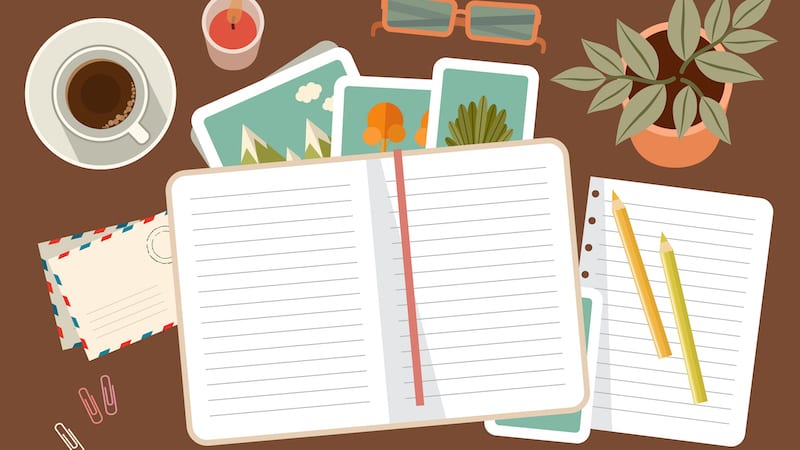
You must do the writing you ask of your students. It’s nothing new, but did you know it’s the single most effective way to get kids writing? If you take the time to do the following five writing assignments, you’ll start to see why finishing this work has a big payoff for teaching it. Bonus points for keeping a notebook about any thoughts and feelings you have while creating these writing examples because you probably won’t remember when you get in front of your students!
Without further ado, here are writing prompts for teachers that you can try now so you have examples to share next year:
1. Share your heart
I first learned this from poet Georgia Heard , but I’ve seen many writing teachers share it. Draw a heart, then write all the things you love inside. Use this heart throughout the year to remind you of writing topics or to help you go deeper when you can’t get enough words on the paper.

Source: @heartmaps
2. Trace your hand and write
Similar to the heart map, writers trace their hand and then write about things they touched that day. This is an exercise writing teachers can do once a month or more since there are so many things to discover inside this five-fingered structure. You’ll find that once your hand starts writing along the fingers, you’ll want to move onto a bigger sheet of paper to keep it going.
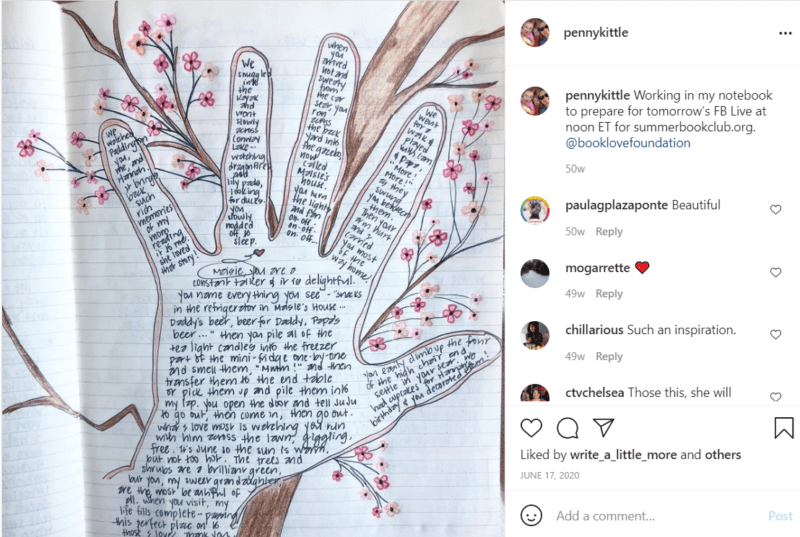
Source: @pennykittle
3. Write a story from a photo
Find a photo with a person or several people in it. It can be one of you or it can be one with strangers. Set it down in front of you and write the story of the photo from the perspective of one of the subjects who were photographed. Get inside the head of that person and write everything you can think about that moment in time. Use all of your senses to bring the scene to life.
Teaching tip: If you do this with kids, display the same photo for the entire class to see. Have them each write their own stories to show how differently one scene can be portrayed.

Source: @old_photos
4. Write beside a poem
Choose a poem you enjoy reading. If you don’t read poetry very much, google poems by Mary Oliver or Billy Collins who write very accessible poetry for everyone. Re-write the poem on one side of a piece of paper. Draw a line down the middle of the paper. Then, write your thoughts or your own poem on the other side of the paper. Don’t be afraid you’ll do it wrong. There is no right or wrong, this is for you. Use this risk-taking assignment to talk with your students later about how you felt while you wrote.
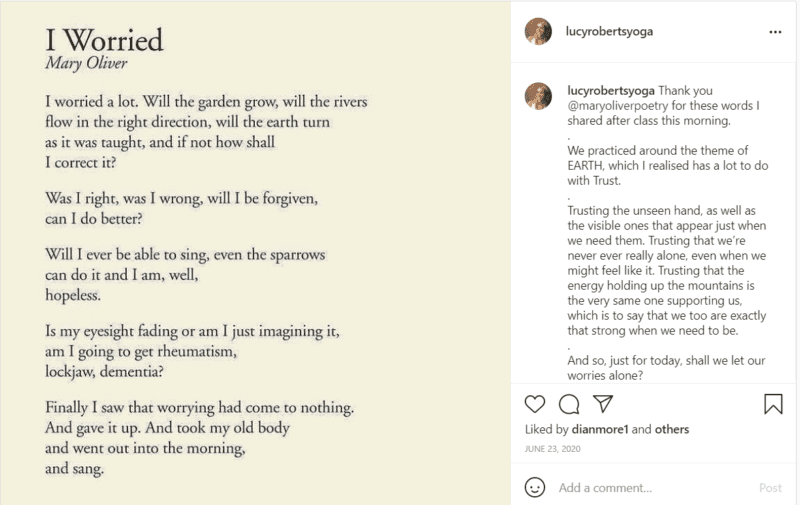
Source: @lucyrobertsyoga
Once you’re done with each of the assignments, put them in a folder or in a notebook to use with your students. When kids see that you’ve done the work you’re asking of them, they will trust you more. They will trust that the process is considered valuable. You may also find you are better able to navigate their journey. Consider how many times you questioned yourself. Think about what problems you had to solve to get yourself to complete the activities. This thought process and experience (especially if you share it out loud) will help your students solve their own writing problems as they creep up.
Do you make different writing samples to share with your students? We’d love to hear about what you do in our WeAreTeachers HELPLINE group on Facebook.
Plus, How I Use Vignettes to Jumpstart Students’ Narrative Writing .
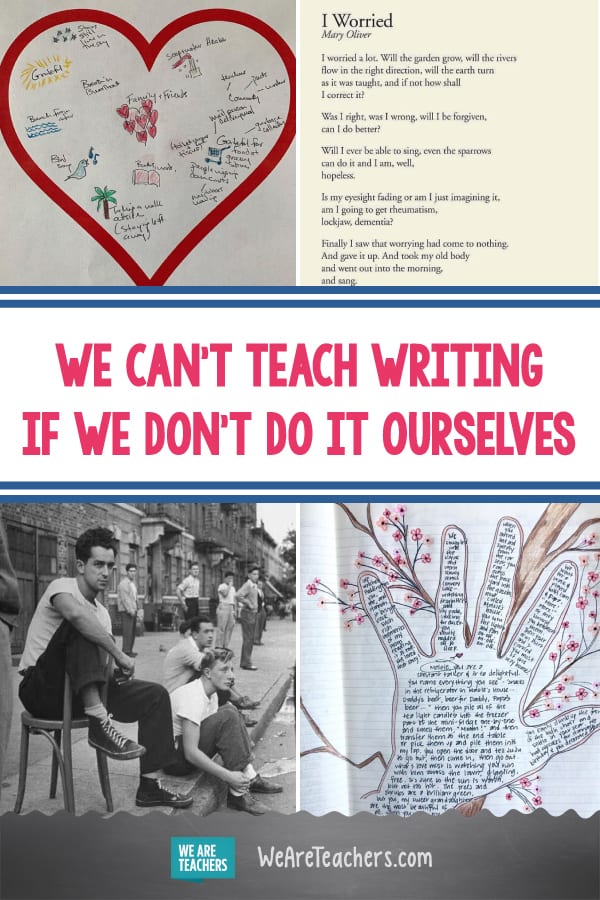
You Might Also Like

Flexible Seating Is All the Rage in Schools, But Does It Really Work?
I wanted to love it, but ... Continue Reading
Copyright © 2023. All rights reserved. 5335 Gate Parkway, Jacksonville, FL 32256
MAKE WAVES WITH THIS FREE WEEKLONG VOCABULARY UNIT!

Topic Sentences in Paragraph Writing- How to Write Topic Sentences in Print and Digital
$ 4.50 Earn 5 Reward Points
You will be amazed when you see what directly teaching five basic Topic Sentences and practicing them using this print and digital resource can do to improve your students’ paragraph introductions!
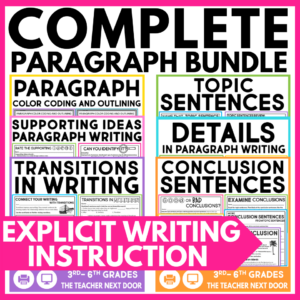
Paragraph Writing Bundle – How to Write a Paragraph – Explicit Writing in Print and Digital
Products included in this bundle:, description.
- Reviews (0)
- Questions & Answers
Do your students struggle to create effective topic sentences? Since directly teaching my students five basic types of topic sentences and having them practice these types in a variety of ways, I’ve been amazed at their progress!
This Topic Sentence resource includes two formats: print and digital, to give you greater teacher flexibility. Besides guided activities and review sheets for each of the five types of topic sentences presented, there’s a topic sentence sorting game, posters, and more to help your students write better topic sentences to introduce paragraphs.
TEACHERS ARE SAYING:
“ This is SO helpful in helping students to learn how to write a topic sentence. It can often be the hardest part of writing, and this helped tremendously!”
– Tammy, 3rd Grade Teacher ⭐⭐⭐⭐⭐
“Loved this resource! My kids really understand topic sentences now and have a variety to choose from. Easy for them to grasp and apply!”
-Karen, 5th Grade SPED Teacher ⭐⭐⭐⭐⭐
“ This resource helped clear up questions and difficulties students were having organizing paragraphs and creating a topic sentence. Everyone liked how the task of writing a topic sentence was broken down into manageable chunks. This resource is also good for differentiation!” – Laura, 4th/5th Grade Teacher ⭐⭐⭐⭐⭐
✅ What’s included? ✅
Topic Sentence Types Posters
Number Words Worksheet
List Statement Worksheet
Two Nouns and Two Commas Worksheet
Occasion/Position Worksheet
Get Their Attention Worksheet
Review Worksheets with all sentence types (3)
Graphic Organizer to Practice One Topic with Five Topic Sentences
Topic Sentence Sorting Game
Topic Sentence Posters (6)
Answer Keys
Teacher Notes (15 detailed pages full of information)
LINKS on the Teacher Notes PDF
⭐ HUGE SAVINGS ⭐ SAVE MORE and GET MORE with the very comprehensive Complete Paragraph Bundle!!! (Click Here)
Other resources included in the Complete Paragraph Writing Bundle can be seen here: (All are print and digital) Paragraph Color Coding and Outlining Transitions in Writing Packet Conclusions Packet: Paragraph Writing
❤️ Why you’ll love this resource: ❤️:
- Directly teaching the skill in isolation allows your students to more fully understand how to create a topic sentence before being asked to write one.
- The print and digital versions make it easy to assign and plan for the classroom or for homeschool.
- The worksheets give your students concentrated practice with this skill while working on it in a variety of activities.
- Students are shown how to write five different types of topic sentences.
- Your students will love the topic sentence game!
- The topic sentence posters provide a nice visual reference for students!
⭐ Have a question? Reach out to us at: [email protected]
©The Teacher Next Door™
One purchase allows one teacher or homeschool parent to use this product in their own classroom. To share with others, please purchase an additional license.
Remember, this resource should only be placed on password-protected websites like Google Classroom™ or SeeSaw and not made available on public platforms or district servers
There are no reviews yet.
Only logged in customers who have purchased this product may leave a review.
Questions and answers of the customers
There are no questions yet, be the first to ask something for this product.
Related products
Related products.

Opinion Writing Essay Bundle – How to Write an Opinion Essay 3rd – 5th grades
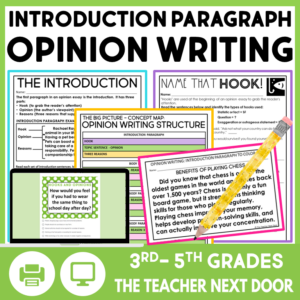
Opinion Writing Introduction Paragraphs – How to Write an Introduction Paragraph
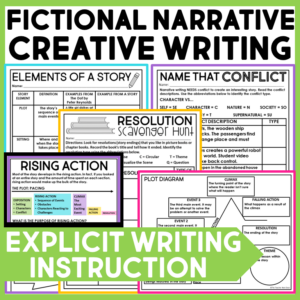
Narrative Writing How To Write a Fictional Narrative Graphic Organizers Activities

JOIN MY NEWSLETTER
Gain access to a library of FREE resources for upper elementary grades!

Facebook Group
Teachers Pay Teachers
Free Resource Library
💌 Contact Us
Disclosures
Privacy Policy
Refund Policy
Purchase Orders
Your Downloads
Reward Points
© The Teacher Next Door, LLC. All rights reserved.

* Please note: If your school has strong email filters, you may wish to use your personal email to ensure access.
Read our research on: Gun Policy | International Conflict | Election 2024
Regions & Countries
What’s it like to be a teacher in america today, public k-12 teachers are stressed about their jobs and few are optimistic about the future of education; many say poverty, absenteeism and mental health are major problems at their school.

Pew Research Center conducted this study to better understand the views and experiences of public K-12 school teachers. The analysis in this report is based on an online survey of 2,531 U.S. public K-12 teachers conducted from Oct. 17 to Nov. 14, 2023. The teachers surveyed are members of RAND’s American Teacher Panel, a nationally representative panel of public K-12 school teachers recruited through MDR Education. Survey data is weighted to state and national teacher characteristics to account for differences in sampling and response to ensure they are representative of the target population.
Here are the questions used for this report , along with responses, and the survey methodology .
Low-poverty , medium-poverty and high-poverty schools are based on the percentage of students eligible for free and reduced-price lunch, as reported by the National Center for Education Statistics (less than 40%, 40%-59% and 60% or more, respectively).
Secondary schools include both middle schools and high schools.
All references to party affiliation include those who lean toward that party. Republicans include those who identify as Republicans and those who say they lean toward the Republican Party. Democrats include those who identify as Democrats and those who say they lean toward the Democratic Party.
Public K-12 schools in the United States face a host of challenges these days – from teacher shortages to the lingering effects of COVID-19 learning loss to political battles over curriculum .
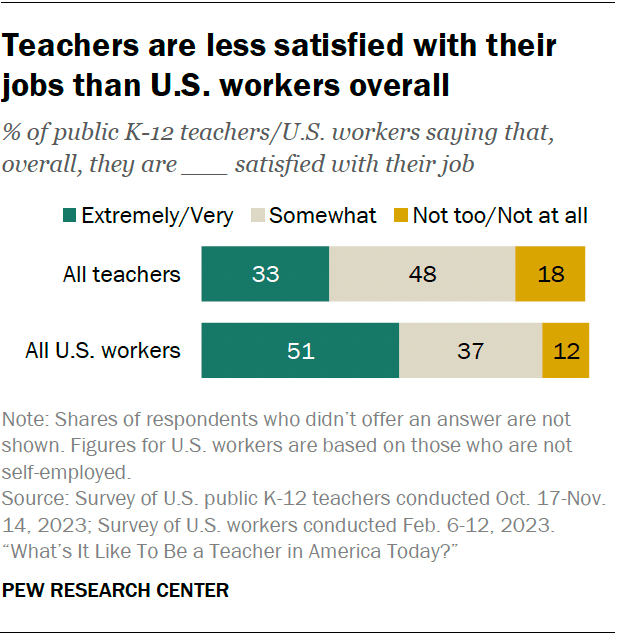
In the midst of all this, teachers express low levels of satisfaction with their jobs. In fact, they’re much less satisfied than U.S. workers overall.
Here’s how public K-12 teachers are feeling about their jobs:
- 77% say their job is frequently stressful.
- 68% say it’s overwhelming.
- 70% say their school is understaffed.
- 52% say they would not advise a young person starting out today to become a teacher.
When it comes to how their students are doing in school, teachers are relatively downbeat about both academic performance and behavior.
Here’s how public K-12 teachers rate academic performance and behavior at their school:
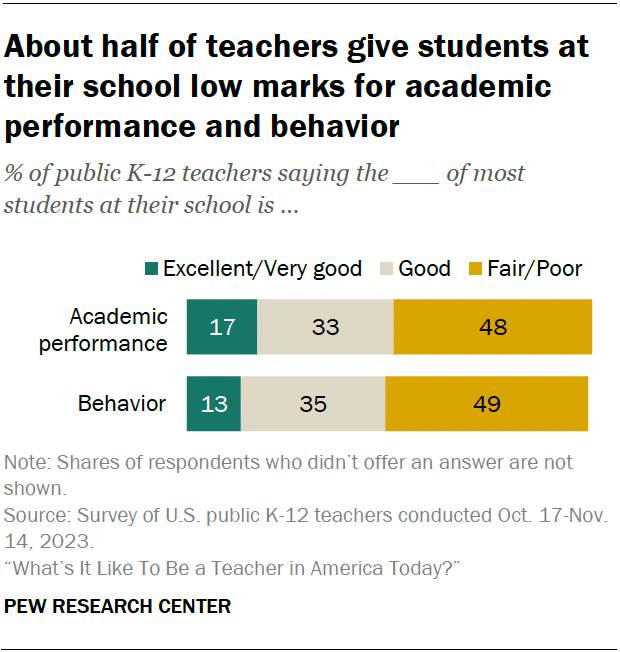
- 48% say the academic performance of most students at their school is fair or poor. A third say it’s good, and only 17% describe it as excellent or very good.
- 49% say the behavior of most students at their school is fair or poor; 35% say it’s good and 13% say it’s excellent or very good.
The COVID-19 pandemic likely compounded these issues. About eight-in-ten teachers (among those who have been teaching for at least a year) say the lasting impact of the pandemic on students’ behavior, academic performance and emotional well-being has been very or somewhat negative.
Assessments of student performance and behavior differ widely by school poverty level. 1 Teachers in high-poverty schools have a much more negative outlook. But feelings of stress and dissatisfaction among teachers are fairly universal, regardless of where they teach.
Related: What Public K-12 Teachers Want Americans To Know About Teaching
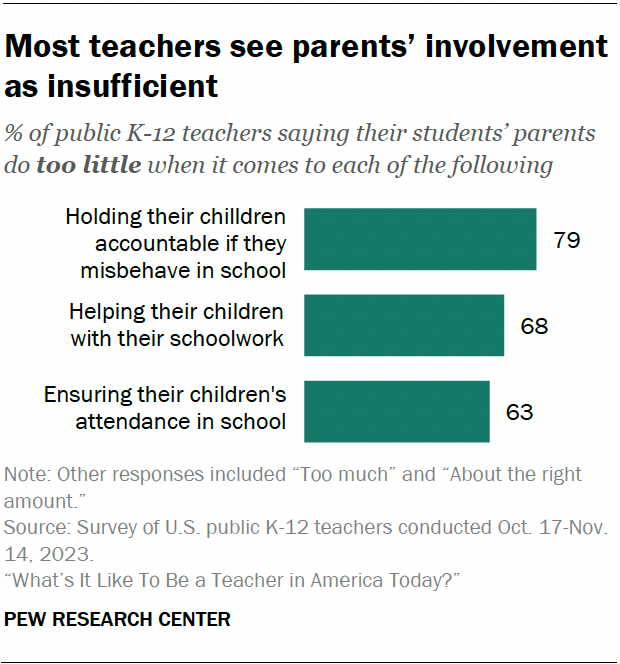
As they navigate these challenges, teachers don’t feel they’re getting the support or reinforcement they need from parents.
Majorities of teachers say parents are doing too little when it comes to holding their children accountable if they misbehave in school, helping them with their schoolwork and ensuring their attendance.
Teachers in high- and medium-poverty schools are more likely than those in low-poverty schools to say parents are doing too little in each of these areas.
These findings are based on a survey of 2,531 U.S. public K-12 teachers conducted Oct. 17-Nov. 14, 2023, using the RAND American Teacher Panel. 2 The survey looks at the following aspects of teachers’ experiences:
- Teachers’ job satisfaction (Chapter 1)
- How teachers manage their workload (Chapter 2)
- Problems students are facing at public K-12 schools (Chapter 3)
- Challenges in the classroom (Chapter 4)
- Teachers’ views of parent involvement (Chapter 5)
- Teachers’ views on the state of public K-12 education (Chapter 6)
Problems students are facing
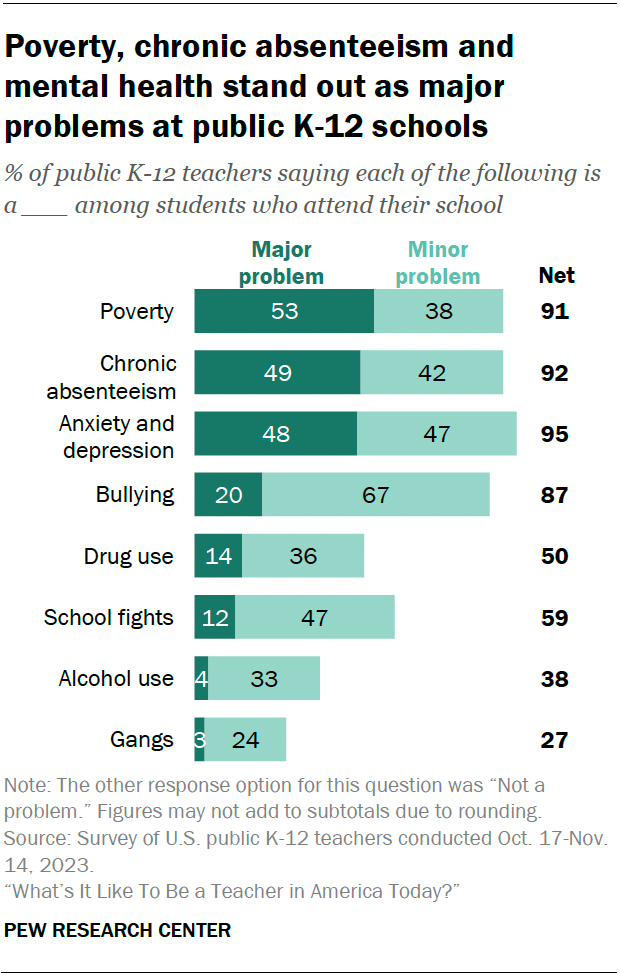
We asked teachers about some of the challenges students at their school are facing. Three problems topped the list:
- Poverty (53% say this is a major problem among students who attend their school)
- Chronic absenteeism (49%)
- Anxiety and depression (48%)
Chronic absenteeism (that is, students missing a substantial number of school days) is a particular challenge at high schools, with 61% of high school teachers saying this is a major problem where they teach. By comparison, 46% of middle school teachers and 43% of elementary school teachers say the same.
Anxiety and depression are viewed as a more serious problem at the secondary school level: 69% of high school teachers and 57% of middle school teachers say this is a major problem among their students, compared with 29% of elementary school teachers.
Fewer teachers (20%) view bullying as a major problem at their school, though the share is significantly higher among middle school teachers (34%).
A look inside the classroom
We also asked teachers how things are going in their classroom and specifically about some of the issues that may get in the way of teaching.
- 47% of teachers say students showing little or no interest in learning is a major problem in their classroom. The share rises to 58% among high school teachers.
- 33% say students being distracted by their cellphones is a major problem. This is particularly an issue for high school teachers, with 72% saying this is a major problem.
- About one-in-five teachers say students getting up and walking around when they’re not supposed to and being disrespectful toward them (21% each) are major problems. Teachers in elementary and middle schools are more likely than those in high schools to see these as challenges.
A majority of teachers (68%) say they’ve experienced verbal abuse from a student – such as being yelled at or threatened. Some 21% say this happens at least a few times a month.
Physical violence is less common. Even so, 40% of teachers say a student has been violent toward them , with 9% saying this happens at least a few times a month.
About two-thirds of teachers (66%) say that the current discipline practices at their school are very or somewhat mild. Only 2% say the discipline practices at their school are very or somewhat harsh, while 31% say they are neither harsh nor mild. Most teachers (67%) say teachers themselves don’t have enough influence in determining discipline practices at their school.
Behavioral issues and mental health challenges
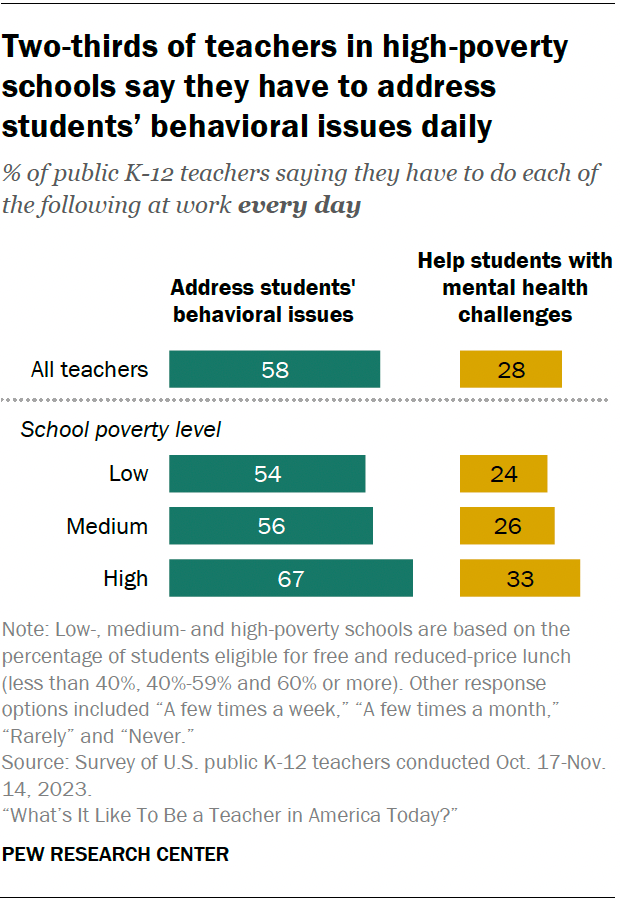
In addition to their teaching duties, a majority of teachers (58%) say they have to address behavioral issues in their classroom every day. About three-in-ten teachers (28%) say they have to help students with mental health challenges daily.
In each of these areas, elementary and middle school teachers are more likely than those at the high school level to say they do these things on a daily basis.
And teachers in high-poverty schools are more likely than those in medium- and low-poverty schools to say they deal with these issues each day.
Cellphone policies and enforcement
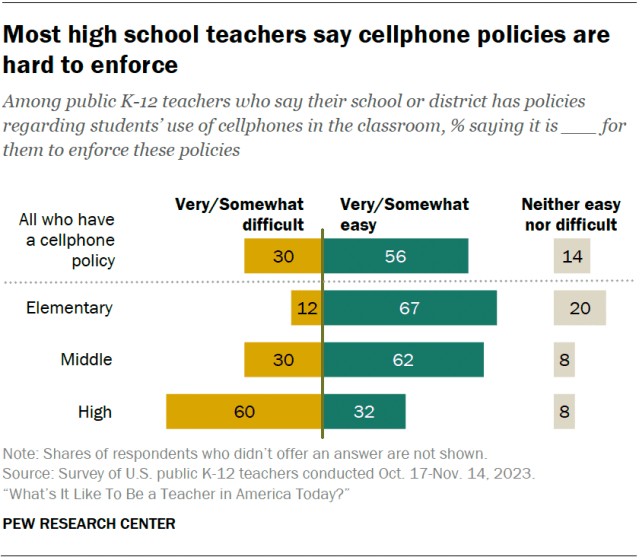
Most teachers (82%) say their school or district has policies regarding cellphone use in the classroom.
Of those, 56% say these policies are at least somewhat easy to enforce, 30% say they’re difficult to enforce, and 14% say they’re neither easy nor difficult to enforce.
Experiences with cellphone policies vary widely across school levels. High school teachers (60%) are much more likely than middle school (30%) and elementary school teachers (12%) to say the policies are difficult to enforce (among those who say their school or district has a cellphone policy).
How teachers are experiencing their jobs
Thinking about the various aspects of their jobs, teachers are most satisfied with their relationship with other teachers at their school (71% are extremely or very satisfied).
They’re least satisfied with how much they’re paid – only 15% are extremely or very satisfied with their pay, while 51% are not too or not at all satisfied.
Among teachers who don’t plan to retire or stop working this year, 29% say it’s at least somewhat likely they will look for a new job in the 2023-24 school year. Within that group, 40% say they would look for a job outside of education, 29% say they’d seek a non-teaching job in education, and only 18% say they’d look for a teaching job at another public K-12 school.
Do teachers find their work fulfilling and enjoyable?
Overall, 56% of teachers say they find their job to be fulfilling extremely often or often; 53% say their job is enjoyable. These are significantly lower than the shares who say their job is frequently stressful (77%) or overwhelming (68%).
Positive experiences are more common among newer teachers. Two-thirds of those who’ve been teaching less than six years say their work is fulfilling extremely often or often, and 62% of this group says their work is frequently enjoyable.
Teachers with longer tenures are somewhat less likely to feel this way. For example, 48% of those who’ve been teaching for six to 10 years say their work is frequently enjoyable.
Balancing the workload
Most teachers (84%) say there’s not enough time during their regular work hours to do tasks like grading, lesson planning, paperwork and answering work emails.
Among those who feel this way, 81% say simply having too much work is a major reason.
Many also point to having to spend time helping students outside the classroom, performing non-teaching duties like lunch duty, and covering other teachers’ classrooms as at least minor reasons they don’t have enough time to get all their work done.
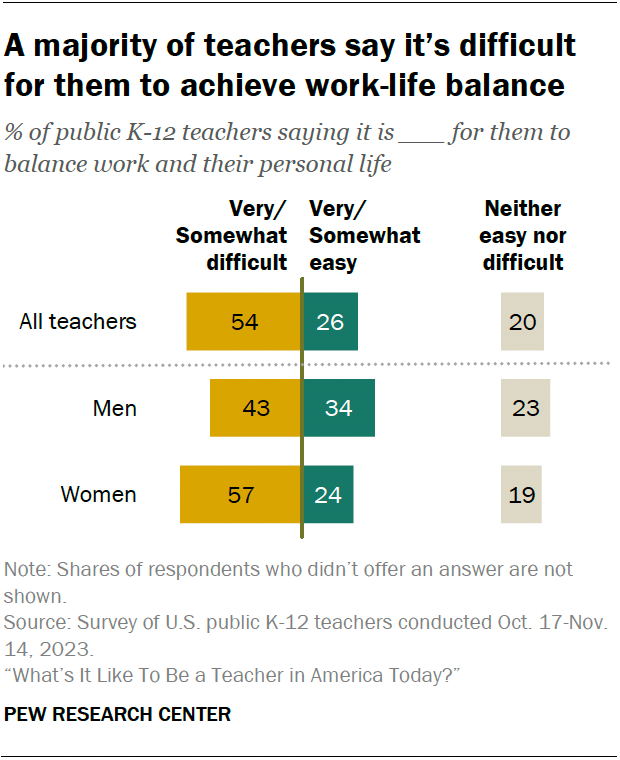
A majority of teachers (54%) say it’s very or somewhat difficult for them to balance work and their personal life. About one-in-four (26%) say it’s very or somewhat easy for them to balance these things, and 20% say it’s neither easy nor difficult.
Among teachers, women are more likely than men to say work-life balance is difficult for them (57% vs. 43%). Women teachers are also more likely to say they often find their job stressful or overwhelming.
How teachers view the education system
A large majority of teachers (82%) say the overall state of public K-12 education has gotten worse in the past five years.
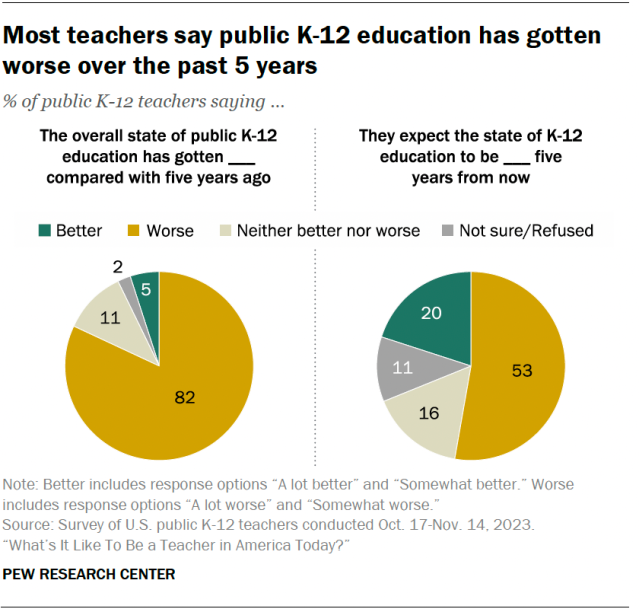
And very few are optimistic about the next five years: Only 20% of teachers say public K-12 education will be a lot or somewhat better five years from now. A narrow majority (53%) say it will be worse.
Among teachers who think things have gotten worse in recent years, majorities say the current political climate (60%) and the lasting effects of the COVID-19 pandemic (57%) are major reasons. A sizable share (46%) also point to changes in the availability of funding and resources.
Related: About half of Americans say public K-12 education is going in the wrong direction
Which political party do teachers trust more to deal with educational challenges?
On balance, more teachers say they trust the Democratic Party than say they trust the Republican Party to do a better job handling key issues facing the K-12 education system. But three-in-ten or more across the following issues say they don’t trust either party:
- Shaping school curriculum (42% say they trust neither party)
- Ensuring teachers have adequate pay and benefits (35%)
- Making schools safer (35%)
- Ensuring adequate funding for schools (33%)
- Ensuring all students have equal access to high-quality K-12 education (31%)
A majority of public K-12 teachers (58%) identify or lean toward the Democratic Party. This is higher than the share among the general public (47%).
- Poverty levels are based on the percentage of students in the school who are eligible for free and reduced-price lunch. ↩
- For details, refer to the Methodology section of the report. ↩
- Urban, suburban and rural schools are based on the location of the school as reported by the National Center for Education Statistics (rural includes town). Definitions match those used by the U.S. Census Bureau. ↩
Social Trends Monthly Newsletter
Sign up to to receive a monthly digest of the Center's latest research on the attitudes and behaviors of Americans in key realms of daily life
Report Materials
Table of contents, ‘back to school’ means anytime from late july to after labor day, depending on where in the u.s. you live, among many u.s. children, reading for fun has become less common, federal data shows, most european students learn english in school, for u.s. teens today, summer means more schooling and less leisure time than in the past, about one-in-six u.s. teachers work second jobs – and not just in the summer, most popular.
About Pew Research Center Pew Research Center is a nonpartisan fact tank that informs the public about the issues, attitudes and trends shaping the world. It conducts public opinion polling, demographic research, media content analysis and other empirical social science research. Pew Research Center does not take policy positions. It is a subsidiary of The Pew Charitable Trusts .
- About the Hub
- Announcements
- Faculty Experts Guide
- Subscribe to the newsletter
Explore by Topic
- Arts+Culture
- Politics+Society
- Science+Technology
- Student Life
- University News
- Voices+Opinion
- About Hub at Work
- Gazette Archive
- Benefits+Perks
- Health+Well-Being
- Current Issue
- About the Magazine
- Past Issues
- Support Johns Hopkins Magazine
- Subscribe to the Magazine
You are using an outdated browser. Please upgrade your browser to improve your experience.
John Barth, towering literary figure and revered mentor, dies at 93
Barth, a johns hopkins graduate who later taught at his alma mater for more than two decades, was known for his postmodernist, unpredictable fiction and his exacting, generous teaching.
By Rachel Wallach
John Barth, A&S '51, '52 (MA), groundbreaking and prolific author, revered teacher, and professor emeritus in The Writing Seminars at Johns Hopkins University, died Tuesday. He was 93.
Image caption: John Barth
Best known for his postmodernist, unpredictable fiction and his exacting and generous teaching, Barth served on the Johns Hopkins faculty from 1973 until he retired in 1995. He is the author of 17 novels and collections of short fiction and three collections of essays. He won a National Book Award, F. Scott Fitzgerald Award for Outstanding Achievement in American Fiction, a Lannan Foundation Lifetime Achievement Award, and the PEN/Malamud Award for Excellence in the Short Story.
"Not just a master of fiction and of the literary essay, John Barth was a rhetorician on the order of a Samuel Johnson," said Jean McGarry , A&S '83 (MA), Academy Professor and Barth's former student and then colleague in The Writing Seminars. "Well-read and deeply thoughtful, it was a pleasure to be in his company, whether as his student or colleague. Passionate about literature, and with peerless taste, he was full of wit and wisdom, and had an almost scientific gift for anatomizing the elements of fiction: bones, flesh, nerves, heart, and lungs. He was also funny, tall, and handsome, and never missed a trick. In a rare way, he epitomized his fiction in his own gallant and witty person."
Barth's upbringing on Maryland's Eastern Shore left a powerful echo in the coastal settings of many of his books as well as the understated, southern lilt to his voice. After almost embarking on a career as a jazz drummer, Barth stumbled into what was then Johns Hopkins' Writing, Speech, and Drama department. In a 1999 oral history with the Sheridan Libraries' Mame Warren that revealed a self-deprecating sense of humor, he credits his "a la carte" education (his job reshelving books from wheeled carts in the classics and Oriental Seminary stacks of the old Gilman library) with filling in much of the literary background he had not yet accrued.
After earning his master's degree at Hopkins, Barth served on the faculty of Penn State, SUNY Buffalo, and Boston University before returning to Hopkins as professor in what had then become The Writing Seminars with a joint appointment in the English department. He invited authors including Salman Rushdie, Grace Paley, John Updike, Raymond Carver, Joyce Carol Oates, and Italo Calvino to read from their work, and they did.
As a teacher, he was famous for never imposing his own style on his students, instead imparting to them a sense of both imagination and craftsmanship. His keen ear as a reader made him a deeply admired mentor; leading by example, he showed students how to dissect stories, listen for style and voice, and discern worthy storytelling—whether in their own writing or that of others.
"One of the delights of sitting in his classroom was hearing him X-ray a story, finding its hidden bone structure and energy source, and still be helpful in cutting away the fat," McGarry wrote for a festschrift for Barth in 2015.
John Barth, writer who pushed storytelling's limits, dies at 93
John barth, novelist who orchestrated literary fantasies, dies at 93.
Michael Martone, A&S '79 (MA), remembers driving to Cambridge, Maryland, for the viewing when Barth's father died. "What I remember is that he told us three stories about funerals he had attended with the usual perfect presentation of his storytelling. It was amazing," said Martone, professor emeritus in the University of Alabama's Department of English. "That even in the midst of that moment he was composing the narratives that would become part of his future narratives and mine. He was all about the story and the famous Freytag pyramid. Stories have beginnings, middles, and ends, and each part needed tending, revising, and amending. And each part is connected, entwined, and harmonic.
"He was my teacher but also my first and always 'outside' reader," Martone added, noting that Barth had pledged on the first day of class to read his former students' published work if they sent it to him. "I did for forty-plus years, everything I published in magazines and books. And he responded every time with a brief note of receipt and a message of thanks and 'keep going, don't stop.'"
Image caption: John Barth is seated at the head of the table in the old board room at Shriver Hall in this image from the 1970s.
Image credit : Courtesy of the Ferdinand Hamburger Archives, Johns Hopkins University
Barth's fiction has been described as striking a commanding balance between postmodern self-consciousness and wordplay, and displays the characterization and compelling plot more common in more traditional genres. In works described as playful and challenging, funny and deadly serious, his plots fragment and his points of view shift. He covered ground from the Chesapeake Bay to the Bronze Age city Mycenae to a generic housing development. His translated works found wide audiences in languages including Finnish, Greek, Hungarian, Italian, Japanese, and Polish, and continue to make significant appearances in public readings, recordings, adaptations, reviews, and critical essays.
Barth's writing veered from the existential to comical nihilism to metafiction; in 1987's "The Tidewater Tales," a minimalist novelist and maximalist oral historian tell each other stories while sailing around the Chesapeake. "Lost in the Funhouse" features a 13-year-old boy exploring Ocean City, Maryland, with his family and simultaneously commenting on his own story, leaving readers reeling between the plot and the commentary as if visiting a boardwalk funhouse. Other best-known works include "The Sot-Weed Factor," "The Floating Opera," "Giles Goat-Boy," and "Chimera," for which he received the National Book Award for fiction in 1973
In 1995, Barth retired from Hopkins and became a senior fellow at Washington College in Chestertown, Maryland. He received an honorary Doctor of Humane Letters degree from Hopkins in 2011, was a fellow of the American Academy of Arts and Sciences, and was elected to the American Academy of Arts and Letters.
The Johns Hopkins Sheridan Libraries hold collections of Barth's manuscripts and books from his personal library, acquired in 2014 . A 2015 exhibit introduced the collection to the public . Typescript drafts with Barth's handwritten corrections offer a glimpse into his writing process, while reviews and critical analyses reveal evolving attitudes toward postmodernism and meta-fiction. The Sheridan Libraries are also processing newly acquired materials, including a set of letters between Barth and his long-time friend and fellow writer Daniel Tamkus. Additional papers can be found at the Library of Congress .
Tagged literature , writing seminars , obituaries , john barth
Related Content
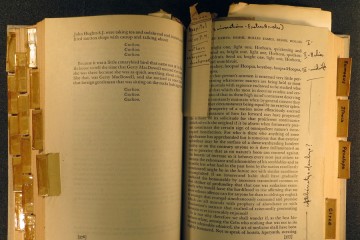
A remembrance of John Barth

Teacher, teacher

A Literary Revival
You might also like, news network.
- Johns Hopkins Magazine
- Get Email Updates
- Submit an Announcement
- Submit an Event
- Privacy Statement
- Accessibility
Discover JHU
- About the University
- Schools & Divisions
- Academic Programs
- Plan a Visit
- my.JohnsHopkins.edu
- © 2024 Johns Hopkins University . All rights reserved.
- University Communications
- 3910 Keswick Rd., Suite N2600, Baltimore, MD
- X Facebook LinkedIn YouTube Instagram

Teachers are using AI to grade essays. But some experts are raising ethical concerns
W hen Diane Gayeski, a professor of strategic communications at Ithaca College, receives an essay from one of her students, she runs part of it through ChatGPT, asking the AI tool to critique and suggest how to improve the work.
“The best way to look at AI for grading is as a teaching assistant or research assistant who might do a first pass … and it does a pretty good job at that,” she told CNN.
She shows her students the feedback from ChatGPT and how the tool rewrote their essay. “I’ll share what I think about their intro, too, and we’ll talk about it,” she said.
Gayeski requires her class of 15 students to do the same: run their draft through ChatGPT to see where they can make improvements.
The emergence of AI is reshaping education, presenting real benefits, such as automating some tasks to free up time for more personalized instruction, but also some big hazards, from issues around accuracy and plagiarism to maintaining integrity.
Both teachers and students are using the new technology. A report by strategy consultant firm Tyton Partners, sponsored by plagiarism detection platform Turnitin, found half of college students used AI tools in Fall 2023. Meanwhile, while fewer faculty members used AI, the percentage grew to 22% of faculty members in the fall of 2023, up from 9% in spring 2023.
Teachers are turning to AI tools and platforms — such as ChatGPT, Writable, Grammarly and EssayGrader — to assist with grading papers, writing feedback, developing lesson plans and creating assignments. They’re also using the burgeoning tools to create quizzes, polls, videos and interactives to up the ante” for what’s expected in the classroom.
Students, on the other hand, are leaning on tools such as ChatGPT and Microsoft CoPilot — which is built into Word, PowerPoint and other products.
But while some schools have formed policies on how students can or can’t use AI for schoolwork, many do not have guidelines for teachers. The practice of using AI for writing feedback or grading assignments also raises ethical considerations. And parents and students who are already spending hundreds of thousands of dollars on tuition may wonder if an endless feedback loop of AI-generated and AI-graded content in college is worth the time and money.
“If teachers use it solely to grade, and the students are using it solely to produce a final product, it’s not going to work,” said Gayeski.
The time and place for AI
How teachers use AI depends on many factors, particularly when it comes to grading, according to Dorothy Leidner, a professor of business ethics at the University of Virginia. If the material being tested in a large class is largely declarative knowledge — so there is a clear right and wrong — then a teacher grading using the AI “might be even superior to human grading,” she told CNN.
AI would allow teachers to grade papers faster and more consistently and avoid fatigue or boredoms, she said.
But Leidner noted when it comes to smaller classes or assignments with less definitive answers, grading should remain personalized so teachers can provide more specific feedback and get to know a student’s work, and, therefore, progress over time.
“A teacher should be responsible for grading but can give some responsibility to the AI,” she said.
She suggested teachers use AI to look at certain metrics — such as structure, language use and grammar — and give a numerical score on those figures. But teachers should then grade students’ work themselves when looking for novelty, creativity and depth of insight.
Leslie Layne, who has been teaching ChatGPT best practices in her writing workshop at the University of Lynchburg in Virginia, said she sees the advantages for teachers but also sees drawbacks.
“Using feedback that is not truly from me seems like it is shortchanging that relationship a little,” she said.
She also sees uploading a student’s work to ChatGPT as a “huge ethical consideration” and potentially a breach of their intellectual property. AI tools like ChatGPT use such entries to train their algorithms on everything from patterns of speech to how to make sentences to facts and figures.
Ethics professor Leidner agreed, saying this should particularly be avoided for doctoral dissertations and master’s theses because the student might hope to publish the work.
“It would not be right to upload the material into the AI without making the students aware of this in advance,” she said. “And maybe students should need to provide consent.”
Some teachers are leaning on software called Writable that uses ChatGPT to help grade papers but is “tokenized,” so essays do not include any personal information, and it’s not shared directly with the system.
Teachers upload essays to the platform, which was recently acquired by education company Houghton Mifflin Harcourt, which then provides suggested feedback for students.
Other educators are using platforms such as Turnitin that boast plagiarism detection tools to help teachers identify when assignments are written by ChatGPT and other AI. But these types of detection tools are far from foolproof; OpenAI shut down its own AI-detection tool last year due to what the company called a “low rate of accuracy.”
Setting standards
Some schools are actively working on policies for both teachers and students. Alan Reid, a research associate in the Center for Research and Reform in Education (CRRE) at Johns Hopkins University, said he recently spent time working with K-12 educators who use GPT tools to create end-of-quarter personalized comments on report cards.
But like Layne, he acknowledged the technology’s ability to write insightful feedback remains “limited.”
He currently sits on a committee at his college that’s authoring an AI policy for faculty and staff; discussions are ongoing, not just for how teachers use AI in the classroom but how it’s used by educators in general.
He acknowledges schools are having conversations about using generative AI tools to create things like promotion and tenure files, performance reviews, and job postings.”
Nicolas Frank, an associate professor of philosophy at University of Lynchburg, said universities and professors need to be on the same page when it comes to policies but need to stay cautious .
“There is a lot of danger in making policies about AI at this stage,” he said.
He worries it’s still too early to understand how AI will be integrated into everyday life. He is also concerned that some administrators who don’t teach in classrooms may craft policy that misses nuances of instruction.
“That may create a danger of oversimplifying the problems with AI use in grading and instruction,” he said. “Oversimplification is how bad policy is made.”
To start, he said educators can identify clear abuses of AI and begin policy-making around those.
Leidner, meanwhile, said universities can be very high level with their guidance, such as making transparency a priority — so students have a right to know when AI is being used to grade their work — and identifying what types of information should never be uploaded into an AI or asked of an AI.
But she said universities must also be open to “regularly reevaluating as the technology and uses evolve.”
For more CNN news and newsletters create an account at CNN.com
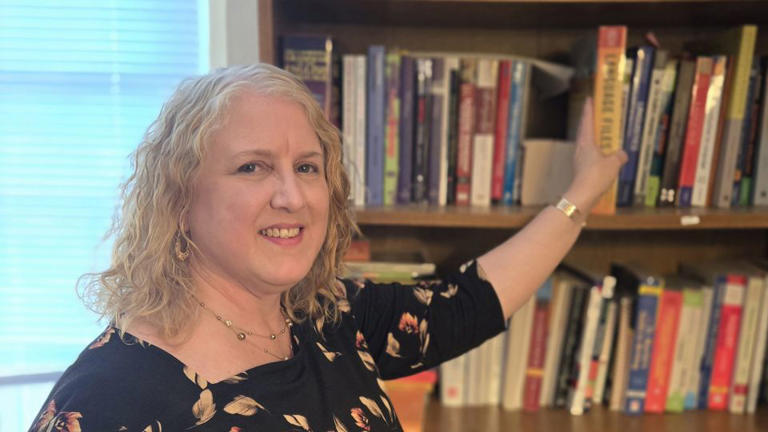
paragraph writing topic
All Formats
Resource types, all resource types.
- Rating Count
- Price (Ascending)
- Price (Descending)
- Most Recent
Paragraph writing topic
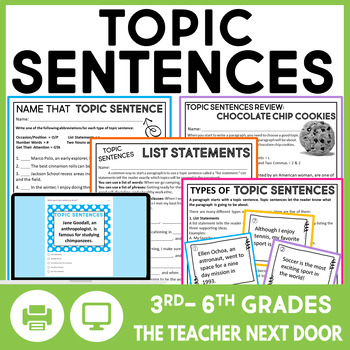
Topic Sentences in Paragraph Writing Activity - How to Write a Topic Sentence

- Google Apps™
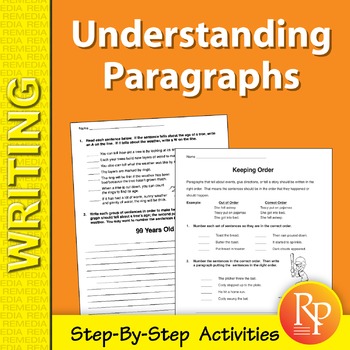
UNDERSTANDING & WRITING PARAGRAPHS - Step-by Step: Topic Sentences/Sequence Ideas

- Internet Activities
- Easel Activity
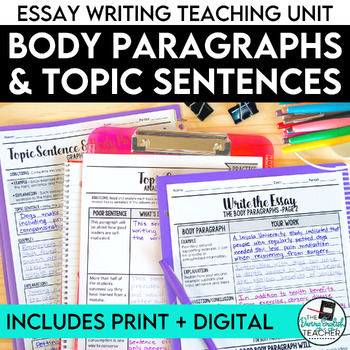
Topic Sentence and Body Paragraph Writing - Essay Writing - PRINT & DIGITAL
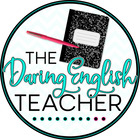
Paragraph Writing Differentiated Topic & Concluding Sentence, Supporting Details

BUNDLE Opinion & Narrative Paragraph Writing Sentence Starters ANY Topic DIGITAL
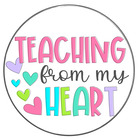
Opinion Paragraph Writing Unit - Opinion Writing Unit - ANY Topic
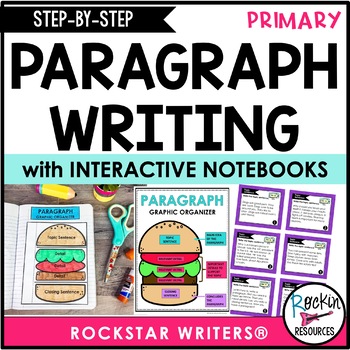
Paragraph Writing for Primary - TOPIC SENTENCES - CLOSING SENTENCE

PARAGRAPH WRITING TOPIC SENTENCE - HOW TO WRITE A PARAGRAPH - DIGITAL
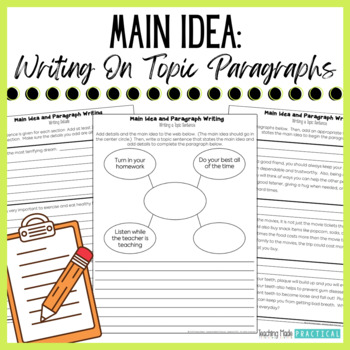
Main Idea Writing - Writing Paragraphs and Staying on Topic

WRITING PARAGRAPHS : Step-by-Step Lessons: Topic Sentences, Sentence Order...

BUNDLE Narrative, Informative, and Opinion Paragraph Writing , ANY Topic
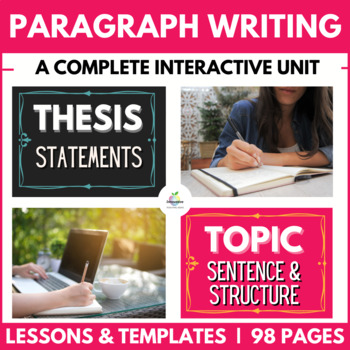
Paragraph Writing Unit | Thesis Statements | Topic & Content Sentence Structure

Informative Paragraph Writing ANY Topic

The Writing Revolution® Single Paragraph Outline/ Topic Sentence - Worksheets

Persuasive Writing Sorting, ideas, topic sentences for paragraphs .
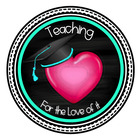
Paragraph Writing - Topic Sentences and Supporting Sentences Activities

Paragraph Writing Practice: Topic & Conclusion Sentences

- Word Document File

Paragraph Writing (for any OPINION topic )

Writing Paragraphs - Structure, Main Idea and Topic Practice - Print & Digital

Paragraph Writing | Topic Sentence Supporting Details and Conclusion Sentence

How To Write a Paragraph : Topic , Details and Closing Sentences

- Google Slides™
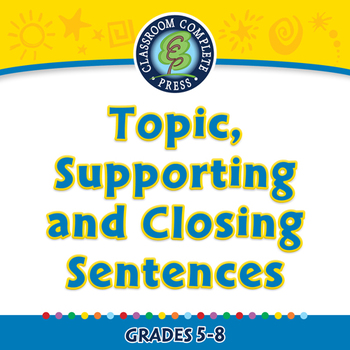
How to Write a Paragraph : Topic , Supporting and Closing Sentences - PC GR. 5-8

- Executable Program File
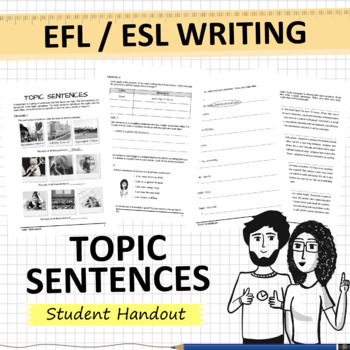
Topic Sentences - Paragraph Writing - ESL EFL English - Main Ideas
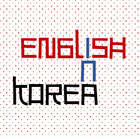
Narrative Writing Anchor Chart, Paragraph Writing , ANY Topic
- We're hiring
- Help & FAQ
- Privacy policy
- Student privacy
- Terms of service
- Tell us what you think

IMAGES
VIDEO
COMMENTS
Paragraph On Teacher: Teaching is one of the noblest professions anyone can opt for, and those who do it are called teachers. Teachers are often very dedicated and knowledgeable, and they gladly pour their knowledge for the better education of children. ... You can read more Paragraph Writing about articles, events, people, sports, technology ...
Paragraph on Teacher in 100 Words. A teacher is a person who helps us learn new things. Think of them like a guide who shows us the path to find out more about the world. They teach us to read, write, and count. They tell us stories and show us how to draw pictures. Teachers answer our questions and help us when things seem hard.
500+ Words Essay on Teacher. Teachers are a special blessing from God to us. They are the ones who build a good nation and make the world a better place. A teacher teaches us the importance of a pen over that of a sword. They are much esteemed in society as they elevate the living standards of people. They are like the building blocks of ...
Here are examples of paragraph writing topics for high school and college students and tutors. Table of Contents. 1 Personal Growth and Development. 2 Education and Learning. 3 Social Issues and Activism. 4 Health and Wellness. 5 Technology and Innovation. 6 Environment and Sustainability. 7 Arts and Culture.
Ideas to Teach Writing a Paragraph. Start with the basics. When teaching students about paragraphs, we talk about the hard and fast rules, such as indenting, having approximately 3-5 sentences, and the structure of it. While I know paragraphs are not set in stone at 3-5 sentences, nor do they always have a main idea as the topic sentence, I ...
Students and teachers who are seeking paragraph writing topics, this is the place where you will get a massive list of 100+ Paragraph Writing Topics from different categories. You will also get some of the examples that have been already written to help you get an idea of how to start writing.
Briefly, here are each of the five topic sentences I introduce: 1. List Statements: A List Statement tells the reader exactly what the paragraph will be about by listing the three supporting ideas. For example: My favorite sports include soccer, football, and basketball. 2.
20 Paragraph Writing Topics | K-12 Learning. Paragraph writing is a necessary skill that benefits kids of all ages and people within a wide variety of industries. This is why educators and teachers know that introducing paragraph writing topics into their classroom curriculum as soon as possible is vitally important. (Thank you teachers!!)
Then we play a game. I name a topic and ask students to write three possible supporting ideas (a word or two, NOT a sentence). So, if I gave the topic of _____ School (my school), some students might write kids, teachers, principal…Other students might write working, learning, playing…Someone else might put classrooms, playground, lunchroom ...
Many times students will write a paragraph with many details but no topic sentence. This activity is a great way to help them formulate a topic sentence. 1. Write a list of details about a topic. build a nest. lay eggs in the nest. sit on the eggs. gather food for the hungry babies. 2.
Point: Make the central argument or express the main idea in the topic sentence. Evidence: Back up the point made by providing evidence or reasons. Evidence may take the form of quotations from a text or authority, reference to historical events, use of statistics etc. Explanation: Explain the point and how the evidence provided supports it. Link: Provide a bridge into the next paragraph at ...
As I frequently mention, we have two ways of viewing and teaching paragraphs, and we want to seesaw between them to some degree: 1. Teaching Isolated Paragraphs: Teachers approach a paragraph as a single whole. 2. Teaching Multi-Paragraph Writing: Teachers approach a paragraph as a part (a division) of a whole composition.
If you are looking for ideas to teach PARAGRAPH WRITING, you are in the right place!It is part of a STEP-BY-STEP WRITING® series of mini-lessons for writer's workshop designed to scaffold through the writing process. Paragraph writing will extend through three posts (lessons 5 topic sentences, 6 relevant details, and 7 closing sentences).
2. Trace your hand and write. Similar to the heart map, writers trace their hand and then write about things they touched that day. This is an exercise writing teachers can do once a month or more since there are so many things to discover inside this five-fingered structure. You'll find that once your hand starts writing along the fingers ...
Paragraph Writing HOW TO WRITE A PARAGRAPH - TOPIC SENTENCES - CLOSING SENTENCES. by. Rockin Resources. 4.8. (541) $11.99. $7.99. Zip. "This is the best and most comprehensive resource I have found on TpT for teaching all of the parts of a paragraph specifically.
Now it's time to put those thoughts onto paper. Start by modeling how to write a clear and concise topic sentence. It's like the superhero of the paragraph—it sets the tone and grabs the reader's attention. Then, model how to provide supporting details that are relevant and compelling. They can be facts, examples, or even personal experiences.
writer announces the current paragraph's topic. However, writing teachers often use the term "topic sentence" as a way to emphasize the rhetorical, or writing, work that the first sentence in a paragraph typically must do. Body sentences or main sentences Through some recognizable or logical order, body sentences develop the
This complete PARAGRAPH WRITING UNIT is designed to take students from zero to hero over FIVE STRATEGIC LESSONS to improve PARAGRAPH WRITING SKILLS through PROVEN TEACHING STRATEGIES.** Please note: This Resource is an excellent option for DISTANCE LEARNING platforms such as Google Classroom, SeeSa
Show and Tell: Display an interesting image or picture in front of your students. It could be anything from a serene landscape to a busy cityscape. Descriptive Writing: Encourage your students to write a paragraph describing what they see in the picture. Emphasize the importance of including a topic sentence, supporting details, and a conclusion.
Most writing handbooks advise that paragraphs have the qualities of unity and coherence. Although what constitutes unity and coherence can be a matter of opinion, both concepts can help students struggling to make their prose clear and their argument easier to follow. A unified paragraph will have a clear focus, with no tangential or off-topic ...
Besides guided activities and review sheets for each of the five types of topic sentences presented, there's a topic sentence sorting game, posters, and more to help your students write better topic sentences to introduce paragraphs. TEACHERS ARE SAYING: "This is SO helpful in helping students to learn how to write a topic sentence. It can ...
77% say their job is frequently stressful. 68% say it's overwhelming. 70% say their school is understaffed. 52% say they would not advise a young person starting out today to become a teacher. When it comes to how their students are doing in school, teachers are relatively downbeat about both academic performance and behavior.
"This is the best and most comprehensive resource I have found on TpT for teaching all of the parts of a paragraph specifically. There are GREAT examples, lessons, and exercises f
Teachers are turning to AI tools and platforms — such as ChatGPT, Writable, Grammarly and EssayGrader — to assist with grading papers, writing feedback, developing lesson plans and creating ...
John Barth, A&S '51, '52 (MA), groundbreaking and prolific author, revered teacher, and professor emeritus in The Writing Seminars at Johns Hopkins University, died Tuesday. He was 93. John Barth. Best known for his postmodernist, unpredictable fiction and his exacting and generous teaching, Barth served on the Johns Hopkins faculty from 1973 ...
Teachers are turning to AI tools and platforms — such as ChatGPT, Writable, Grammarly and EssayGrader — to assist with grading papers, writing feedback, developing lesson plans and creating ...
"This is the best and most comprehensive resource I have found on TpT for teaching all of the parts of a paragraph specifically. There are GREAT examples, lessons, and exercises f